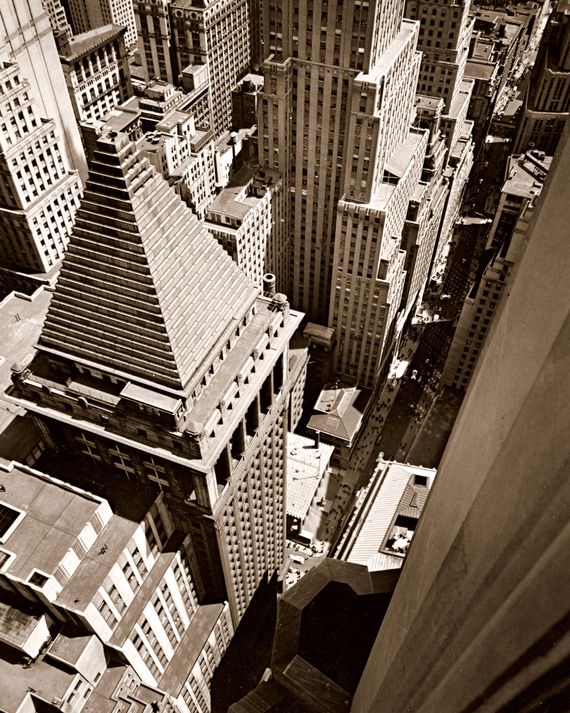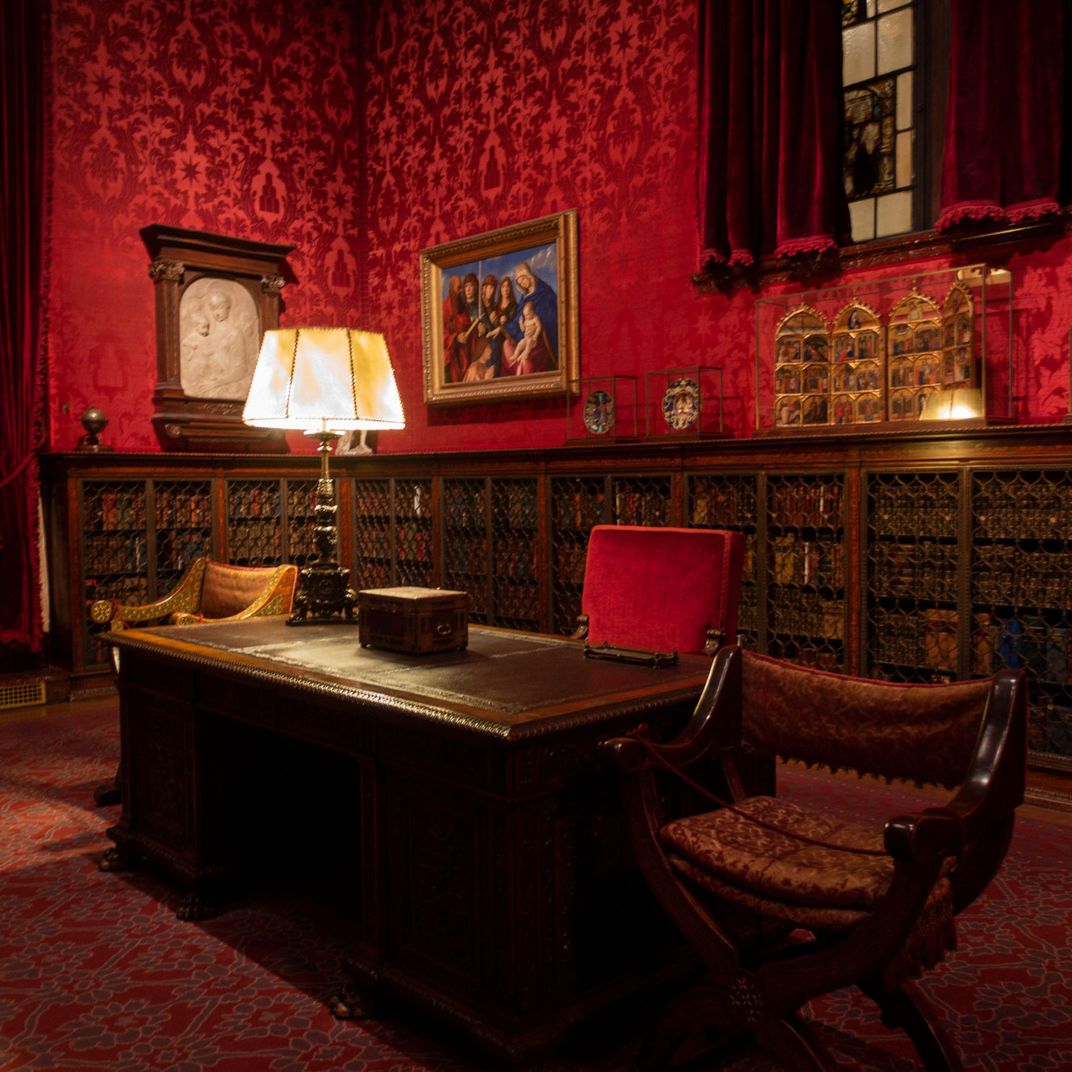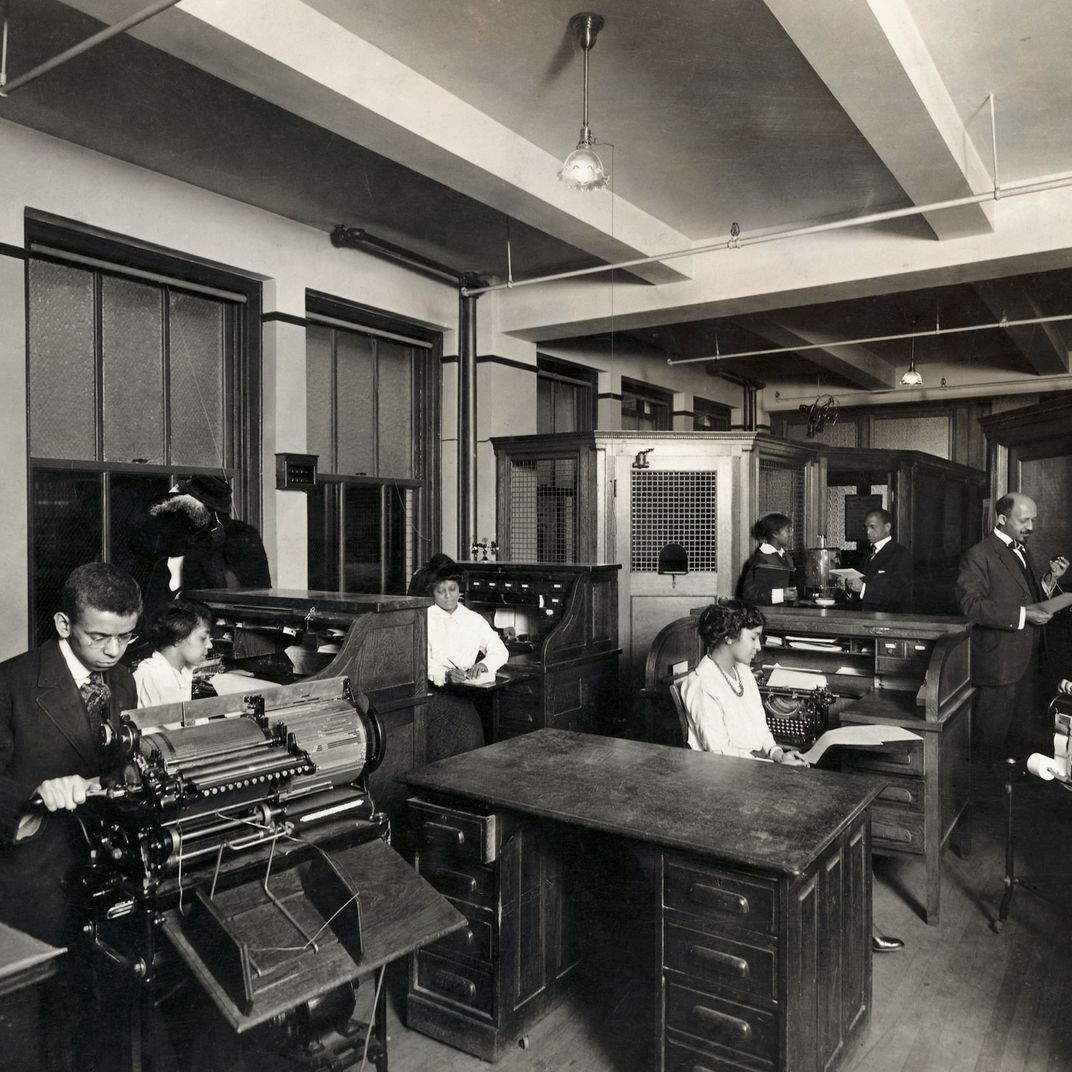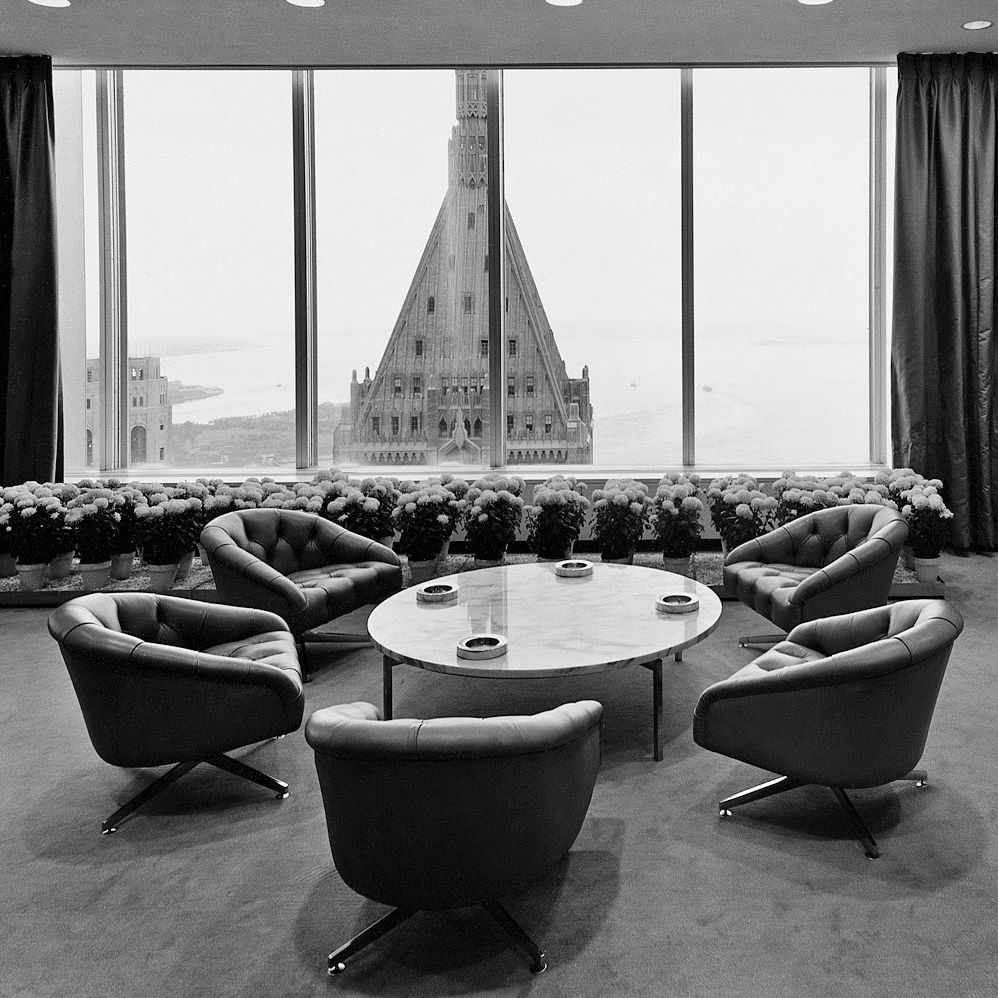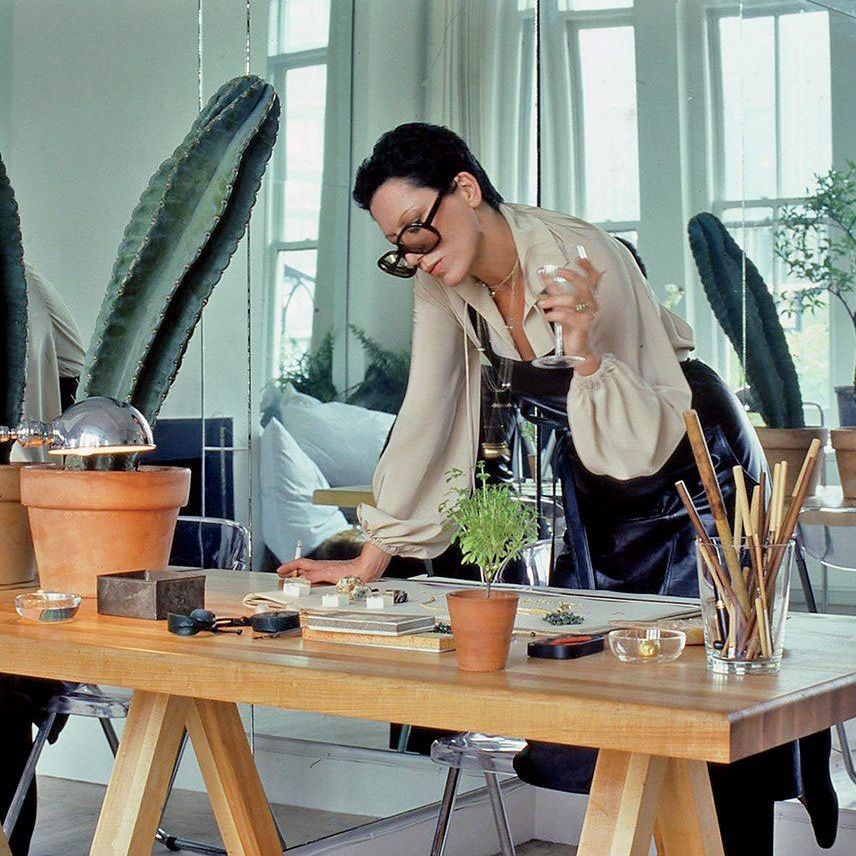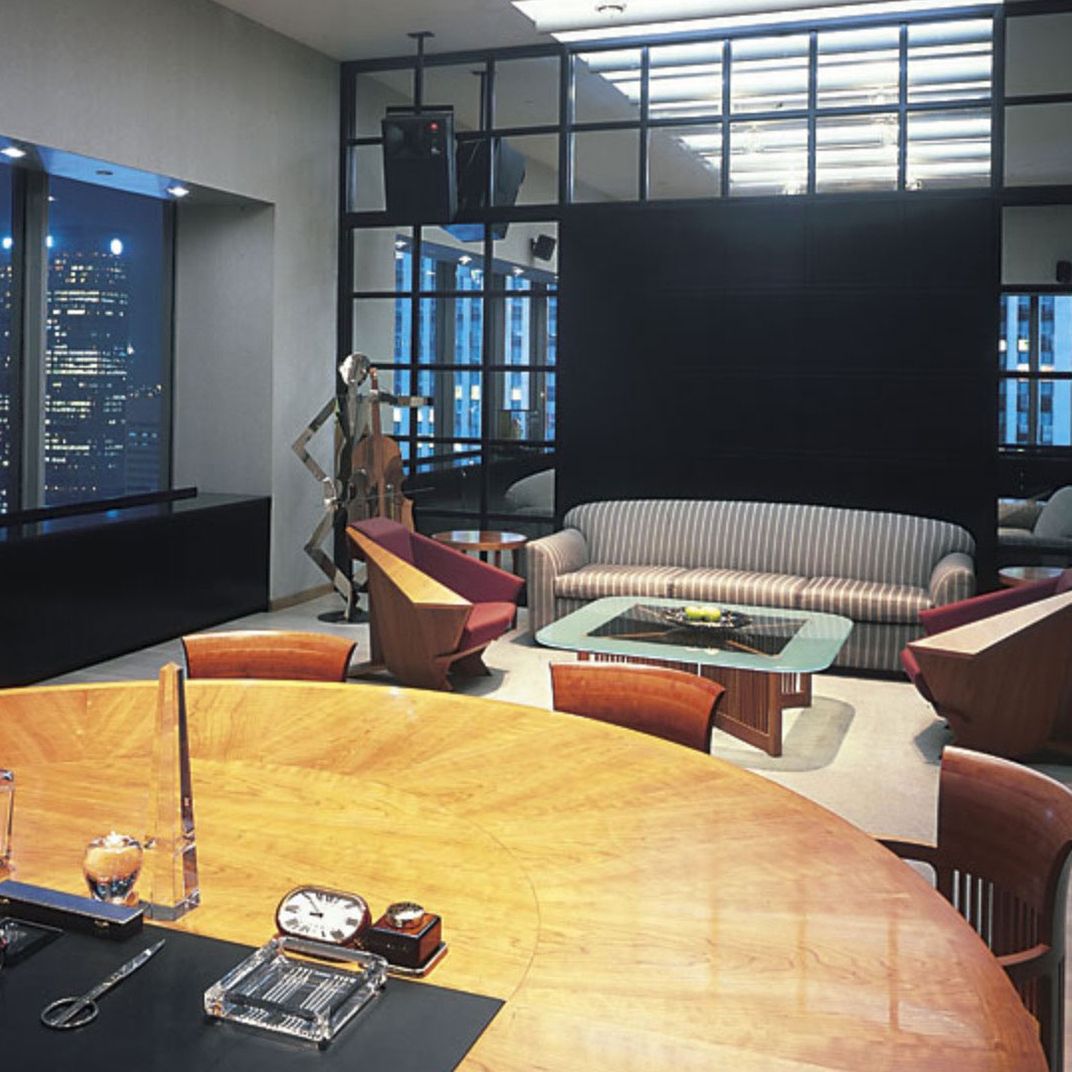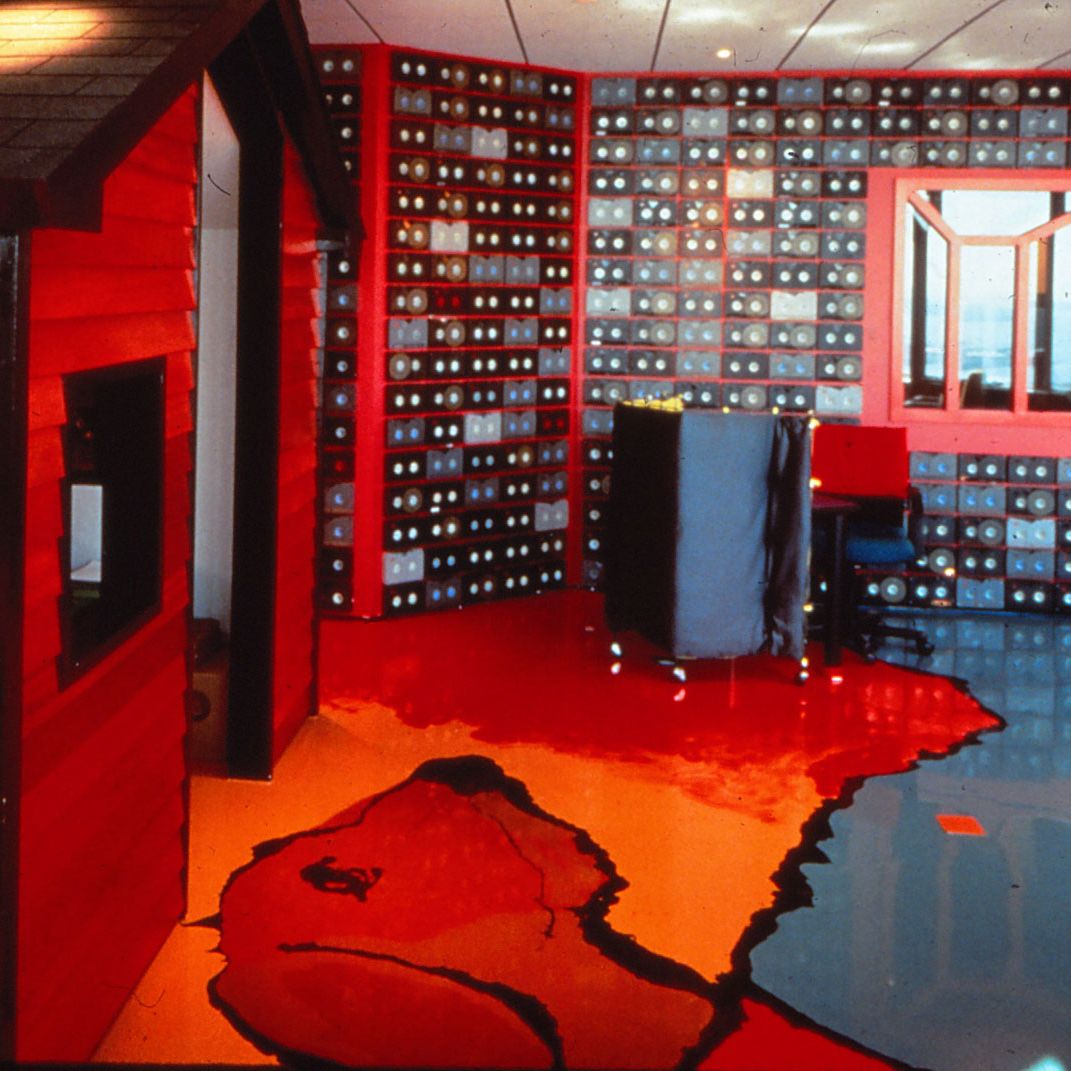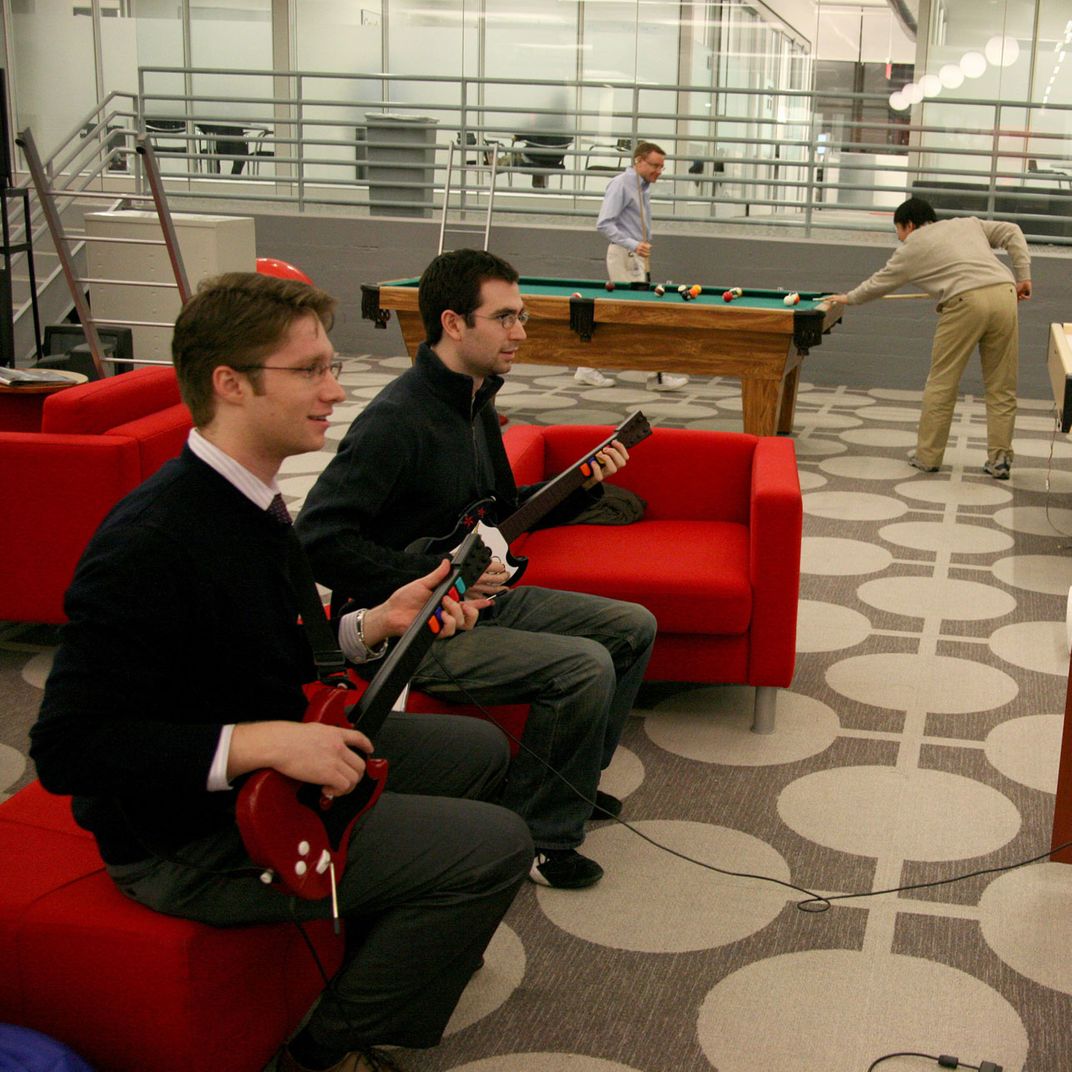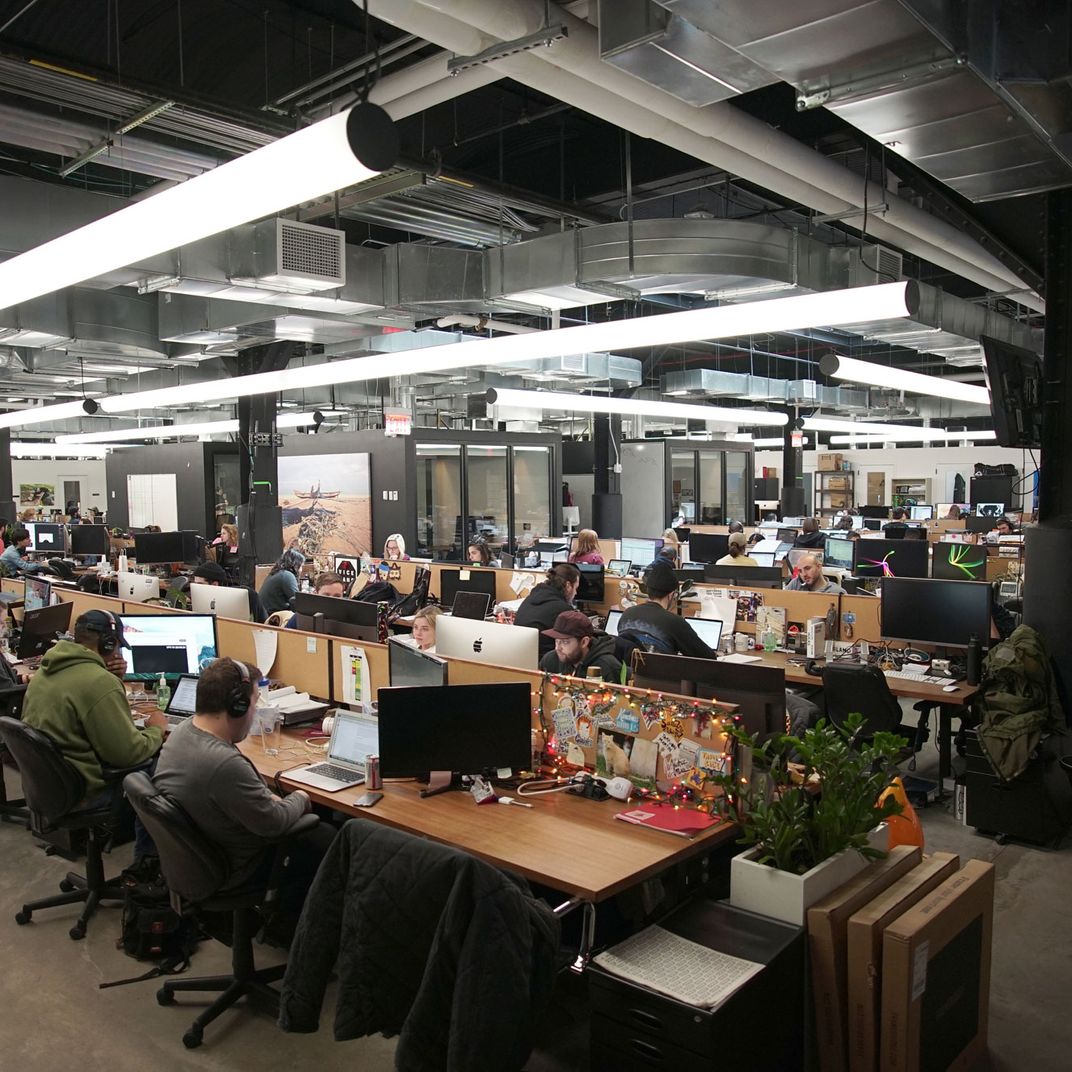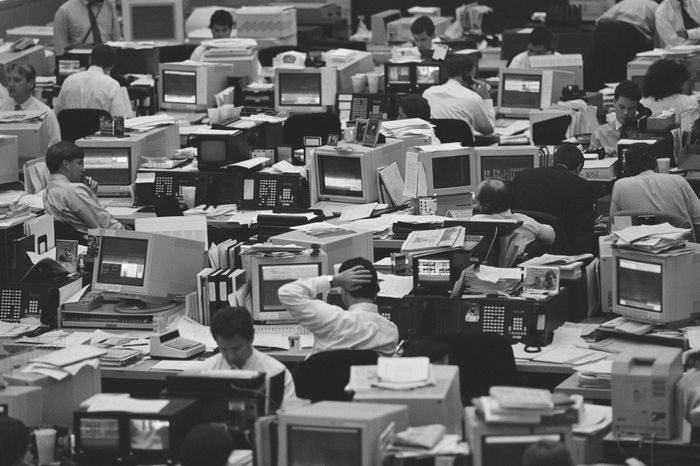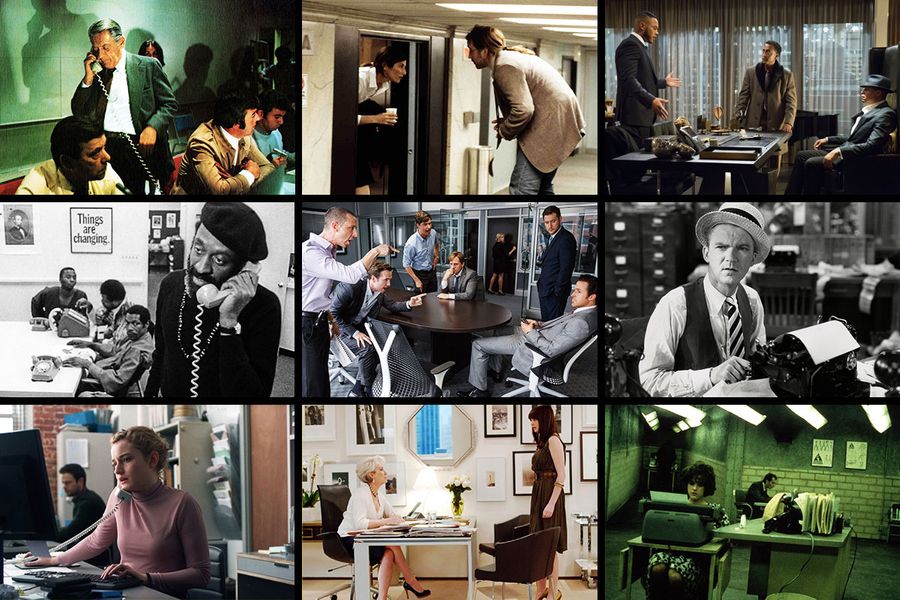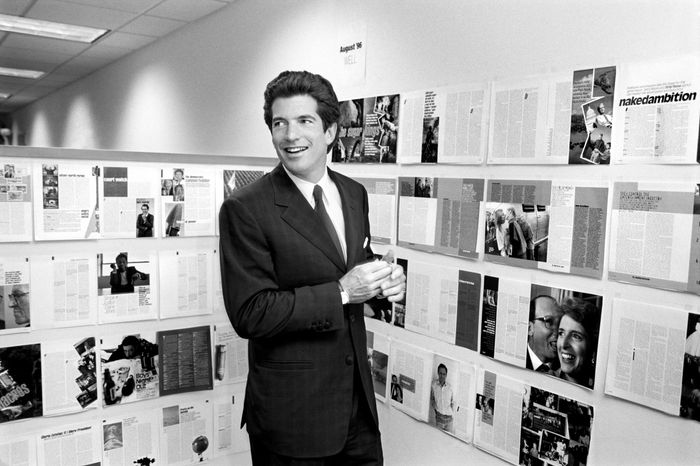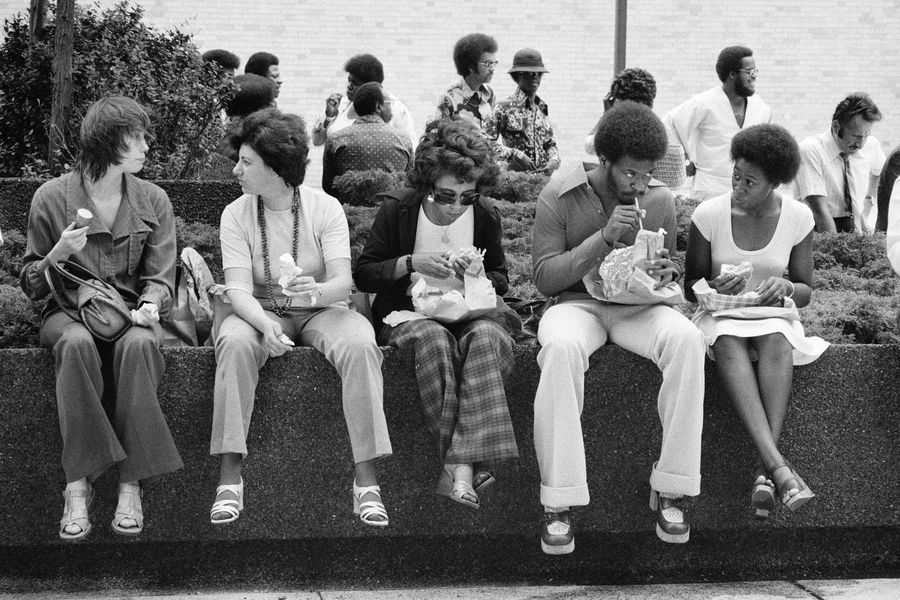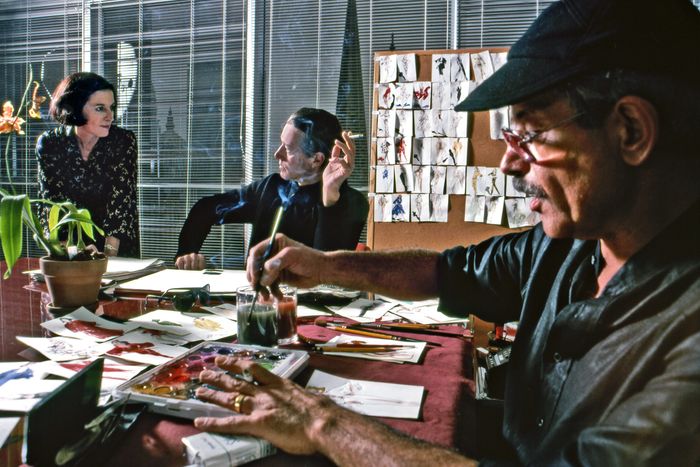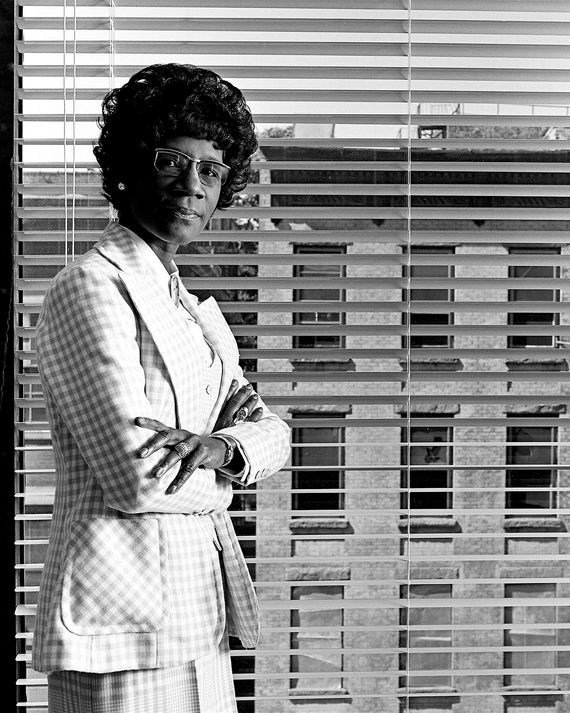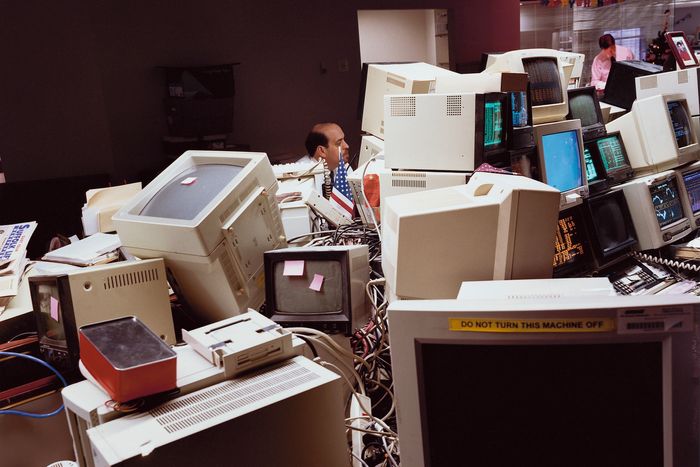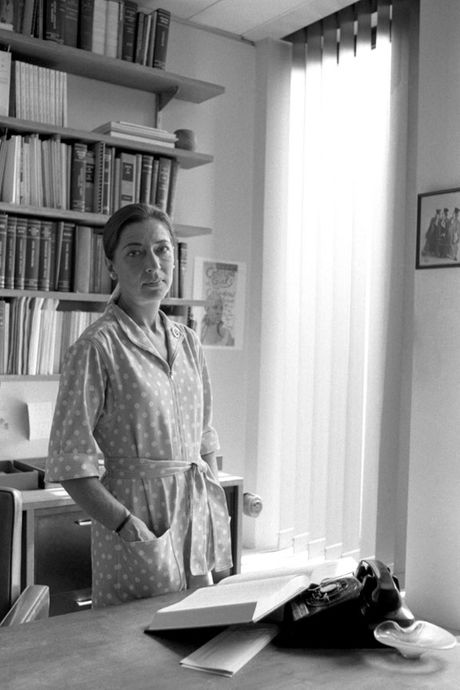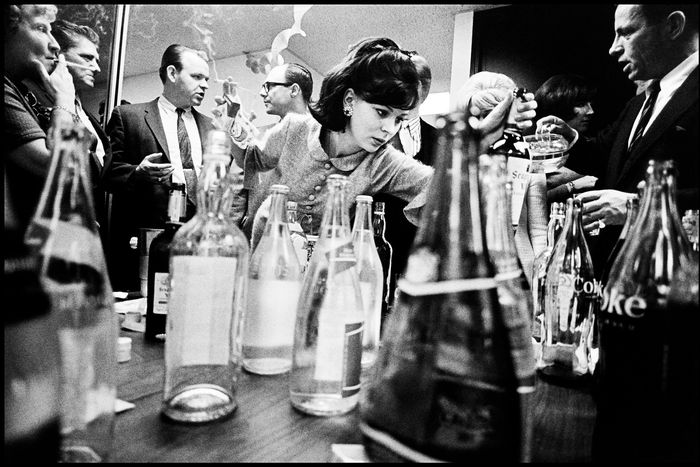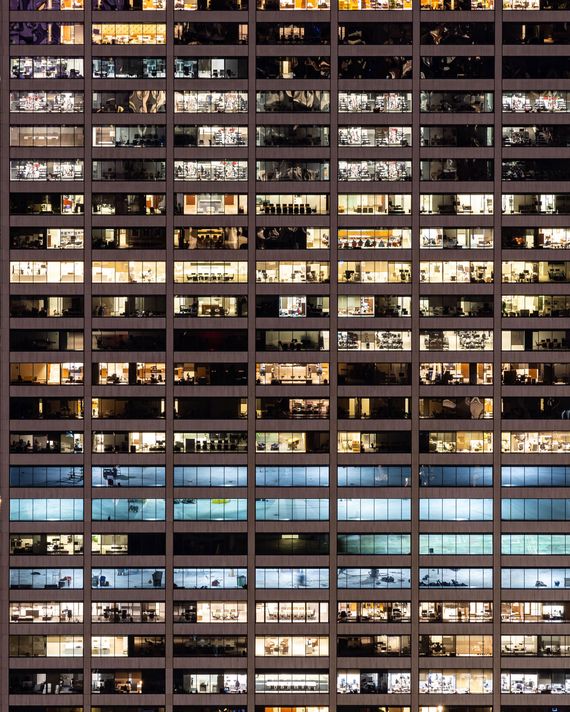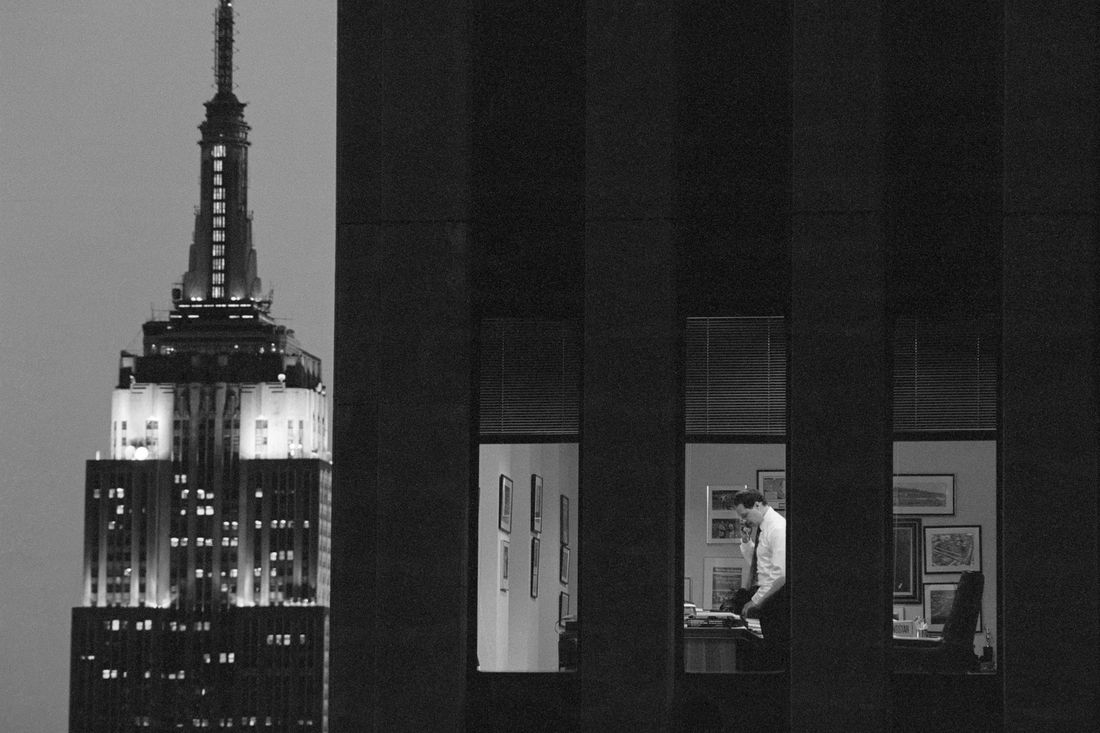
This article was featured in One Great Story, New York’s reading recommendation newsletter. Sign up here to get it nightly.
What I want out of office gossip is what Herman Melville delivers in “Bartleby, the Scrivener,” Ur-text of Manhattan office life. Imagine hearing it over happy-hour beers some Thursday night. A new clerk arrives at a Wall Street law firm, and at first everything seems normal — quiet guy, efficient, neat. Bartleby eats literally nothing except the ginger-nut cookies that the intern (everyone calls the intern Ginger Nut) always buys. But, you know, basically, he’s fine. Then Bartleby starts refusing to do things. He says he “prefers not to.” He prefers not to go to the post office. He prefers not to double-check his work. The boss has no idea what he’s supposed to say to that. Meanwhile, Bartleby has apparently started sleeping at the office, so now he’s just there all the time, eating ginger nuts and semi-doing his job. Finally, the boss tries to fire him, but no; Bartleby prefers not to leave.
This is the good stuff, in my opinion. A clash of personalities. A power struggle. The fathomless mysteries of other people, the capacity of their quiet behaviors to obsess and derange. The potential for petty personal weirdness to yield institutional crisis. Bartleby’s employer picks up and moves to a new office to get away from him: incredible. When I think about office life, this is what I miss.
Once, the office would have seemed an unlikely object of nostalgia. Whether you were working in an office that was depressing because it tried too hard to be fun or an office that was depressing because it was depressing, going there meant submitting to various forms of low-level irritation (at the very least). Air-conditioning cold enough to make your fingers ache. Elevator small talk. Mediocre salads from the place downstairs. You might well have preferred not to, even if you didn’t feel you could say as much. Yet somehow, a year’s absence from that HVAC terrarium has felt like a loss. The confines and routines of the office turned out to be its charm. They’re what allowed its occupants — in all their eccentricity — to shine. Bartleby’s office had a view of a wall and an air shaft; perhaps yours had a view of cubicles and more cubicles. Cramped quarters mean sustained acquaintance with colleagues’ habits, moods, and snacks. And more than that, they encourage a collective effort to figure out how the workplace works: They encourage gossip, which can be as much analysis as breaking news. I miss collapsing on a couch to dissect a meeting that finished five minutes prior. I miss ducking into empty conference rooms to debrief. I miss being told to shut the door. All those warrens of office chatter! During the pandemic, it was startling to realize I didn’t exactly need the office and startling to miss it anyway.
This issue resumes a recent tradition of celebrating the anniversary of New York’s founding with an issue that explores its namesake city’s past through one specific lens. And after a year of staring at each other’s heads on Zoom, our choice this year was obvious: an anniversary issue dedicated to examining the history of the New York office, both the physical space and the human dramas that took place across cubicles and behind closed doors. The workplace we find when we return will no doubt be different from the one we used to know. What better time to ask how the office might be remade to the serve the people who spend their days there? “Bartleby” is a reminder: Business as usual is never as fixed as it seems. — Molly Fischer
What Was the Office?
Chapter One
And the office, in turn, made modern New York.
By Justin Davidson
Morning rush, 1896. The Third Avenue elevated train clatters into 23rd Street. A young woman trudges down the iron stairs, plucks her skirts just clear of the sidewalk, and joins the torrent of men in dark suits and women in white blouses converging on Madison Square. It’s taken a lot of convincing to get to this first day of work. Her parents know the neighborhood as a den of the disreputable rich, where bright new mansions are interspersed with the concert saloons that the Reverend Parkhurst is so bent on expunging. A few blocks up is Madison Square Garden, with its boxers and opera singers. (“Tonight and Friday evening will be Wagner nights,” the Times warned. “Every night there will be beer.”) And an office is no place for a girl either. Her father should know, having spent decades hunched over an oak desk in a shipping company’s lightless front room along with a dozen other sallow men.
But everything is different now. A few years ago, the Metropolitan Life Insurance Company built itself an 11-story palazzo at the corner of Madison Avenue and East 23rd Street, and it’s practically a billboard for respectability. Men — clerks, accountants, executives, cashiers — enter through one portal. An even larger group of typists, stenographers, and switchboard operators flows through another: “Metropolitan Belles,” the company calls its young unmarried female employees, with their brisk step and pinned-up hair. There’s no risk of their bumping into a man, the young woman has assured her mother, because elevators, hallways, and lunchrooms are segregated with monastic strictness. She won’t mention the roof terrace, where the sexes mingle during breaks.
New York City and the office transformed each other at the end of the 19th century so quickly and profoundly that it makes the digital age seem sluggish. Read how the office became “an information factory on a colossal scale” ➼
The Status Office
An incomplete history.
1906: Office as throne room.
J.P. Morgan received visitors in his opulent study. Here, during the Panic of 1907, he arranged — and to a large extent bankrolled — a bailout of the U.S. economy.
1910: Office as center for social change.
During its early years, the NAACP was headquartered in New York, as were the editorial offices of its magazine, ‘The Crisis.’
1961: Office as reputation burnisher.
Chase Manhattan Plaza’s high modernism conveyed steadiness and fastidiousness: How could such a spotless institution ever mess up your money?
1974: Office as groovy tastemaker’s enclave.
Elsa Peretti designed jewelry from her worktable-desk, equipped with cactus, cigarette, and wine.
1988: Office as tasteful design museum.
SBK Entertainment was kitted out by Gwathmey Siegel with look-we-have-class Frank Lloyd Wright furniture and a Wiener Werkstätte grid wall.
1994: Office as postmodern idea riot.
Gaetano Pesce’s workspace for Chiat\Day had a resin floor in which stars and puppies were “drawn” by pouring, with computers in rolling carrels for flexibility.
2006: Office as rumpus room.
Google brought its Silicon Valley habits to New York, creating a giant cocoon packed with play that many employees actively chose not to leave. Clever!
2010: Office as extension of apartment.
WeWork chopped up the corporate floorplate into bits that solo workers and small companies could rent, often close to home, and added good coffee and lounges.
2016: Office as shop floor.
Tech and media brought back the wide-open, cubicle-free style that dominated a century ago. Everyone claims to like the collaborative environment; nobody actually does.
1906: Office as throne room.
J.P. Morgan received visitors in his opulent study. Here, during the Panic of 1907, he arranged — and to a large extent bankrolled — a bailout of the U.S. economy.
1910: Office as center for social change.
During its early years, the NAACP was headquartered in New York, as were the editorial offices of its magazine, ‘The Crisis.’
1961: Office as reputation burnisher.
Chase Manhattan Plaza’s high modernism conveyed steadiness and fastidiousness: How could such a spotless institution ever mess up your money?
1974: Office as groovy tastemaker’s enclave.
Elsa Peretti designed jewelry from her worktable-desk, equipped with cactus, cigarette, and wine.
1988: Office as tasteful design museum.
SBK Entertainment was kitted out by Gwathmey Siegel with look-we-have-class Frank Lloyd Wright furniture and a Wiener Werkstätte grid wall.
1994: Office as postmodern idea riot.
Gaetano Pesce’s workspace for Chiat\Day had a resin floor in which stars and puppies were “drawn” by pouring, with computers in rolling carrels for flexibility.
2006: Office as rumpus room.
Google brought its Silicon Valley habits to New York, creating a giant cocoon packed with play that many employees actively chose not to leave. Clever!
2010: Office as extension of apartment.
WeWork chopped up the corporate floorplate into bits that solo workers and small companies could rent, often close to home, and added good coffee and lounges.
2016: Office as shop floor.
Tech and media brought back the wide-open, cubicle-free style that dominated a century ago. Everyone claims to like the collaborative environment; nobody actually does.
Chapter Two
It Was Stressful, Filthy, High Stakes — and Where the Action Was
The Exquisite Pleasure of a Dead-End Job
By Mark Harris
I got my first real job in midtown Manhattan on Sixth Avenue. Or, I should say, off Sixth. This was not the Avenue of the Americas of Time Inc. and other places to which I aspired. I was with a small company hanging on for dear life above an Indian restaurant in a dilapidated five-story building with stairs behind a steel door and an ancient elevator that would as soon plunge you into hell as take you up 25 feet.
The office had once been somebody’s long, narrow apartment and was now the home of the ancient-times version of a content farm. At the back end were two rooms, each with three or four desks and an ever-rotating group of sallow young men like me, who were hired to produce capsule movie reviews for an encyclopedic book intended to capitalize on the new craze for videocassettes. I was paid $275 off the books for a 45-hour week. The checks were handed out just irregularly enough to keep everyone in a constant state of anxiety and grievance. Read about the dirty deeds, office drama, and pay irregularities of a starter job ➼
Working at Saturday Night Live, 1975
If You Never Leave, You May As Well Make Yourself at Home
Anne Beatts, writer: It was customary to spend Tuesday nights at 30 Rock. My office was a window-width one on the 17th floor with a two-cushion green vinyl couch. I’d wake up drooling, with green stains on my mouth, so when I negotiated my second-year contract, I asked for a hospital bed. The office wasn’t big enough for both it and a desk, so I had a tray table for my typewriter and a phone on the wall. To keep it fresh, I’d bring in flowers, clean sheets, and a different outfit to change into every week. Inspired by me, Danny Aykroyd and John Belushi got bunk beds for their office, which always had a dank, frat-boy smell.
On Wednesdays, I’d leave a note for the receptionist to wake me up at nine, then I’d wake up my writing partner, Rosie Shuster. If we had time, we’d eat breakfast downstairs; during tough weeks, we’d order in and tip the delivery guy, Raymond, in joints. We’d frantically type up scripts and write them out longhand on yellow pads, tape them together, and push them out under the door for the PAs to pick up before the three o’clock read-through.
Once, I was writing a thing for Gilda Radner, and we were on the phone at midnight. She was down in the Village in her apartment and said she’d come to the office to work on it. She showed up wearing her pajamas, which might have been footie pajamas, and admitted she’d changed into them just for the joke. She’d do anything to get a laugh. That was my life for five years. During the off weeks, we’d try to catch up on sleep, laundry, and returning calls, but there was never enough time. I’d have nightmares like “Lorne wants you in his office!” and “You’re running late!” I still have those dreams 40 years later. [Beatts died a week after giving this interview, at age 74.]
Working at Skadden Arps, 1985
There Are Rules. No. 1: Never Cry.
Nancy Lieberman, lawyer: It always happened on a Friday afternoon. You’d be working on a merger, doing research, writing memos — and then all of a sudden it would get the green light. The partner would say, “I need to see something by Sunday.” This is like a Friday at five o’clock. They would say, “Make it a hell-or-high-water agreement,” which meant that the deal had to happen virtually no matter what.
I got asked to work on Allied Chemical and Signal Company — a $12 billion deal, the largest non-oil-company merger ever done. I was 28. I did USX Corp, when Carl Icahn tried a takeover; when Rite Aid bought Hook Drug; Santa Fe–Southern Pacific.
We would take over a conference room; that became the war room. No ventilation, no open windows. You had to mark up the entire agreement by hand. Everything was under a code name — you lived in fear of the deal leaking. Sometimes you felt like you’d only been there for an hour and then you’d look at your watch and it’d be 3 a.m. You could order dinner from any place you wanted, but sometimes you were so hyped you weren’t hungry.
I knew rule No. 1: You can’t cry. As a woman, you never cry. I would cry in the bathroom sometimes. But there was sometimes yelling in the war rooms. Once, we were marking up a hostile tender offer, and this associate started yelling, “It’s my father’s 50th birthday, and I’m stuck here with you.” I looked at him and yelled back, “Well, today is my grandmother’s 85th.”
I used to leave something I could wear to a club or party in my office so I could go out for a couple of hours with my friends. Then I’d come back at one in the morning and finish up. When I made partner, they had a full bathroom right across from my office with a bathtub and a shower. I spent more time there than I did in my apartment.
At the end of an all-nighter, it smelled like a gym. Crumpled Xerox paper on the floor, coffee cups, Chinese-food containers. It was the worst. Then you’d see the story in the newspaper. And that was fun.
Working at Atlantic Records, 1967
‘We Funkified It, If You Know What I Mean’
Jerry Greenberg, music executive: I joined Atlantic Records as Jerry Wexler’s assistant, but he saw that I had a good ear for signing acts. The first artist, I went to Jerry and I said, “I just heard a record from a group in Texas. I really like it.” He goes, “Make the deal, I don’t even have to hear it. I trust you.” It turns out to be Archie Bell & the Drells, “Tighten Up,” which was a top-ten record. I signed Foreigner, Chic, Genesis, the Blues Brothers, the Muppets. Eventually, at 32, I became president of the company.
Having our own studio was great because I could walk in and watch Aretha record; I watched Cream record. If you walked down the halls, you heard music coming out of all the offices. Unfortunately, these days, I’ve been to some record companies and it’s almost like walking into an insurance company. You don’t hear the music; you don’t feel the excitement. When we would get a record on a big radio station, everybody’d be running down the halls screaming and yelling. We’d have once-a-week marketing meetings, and there’d be 30 people in there listening to new records, listening to singles. Everybody at Atlantic Records was a part of music. And artists knew they could come up there and hang out.
Our office was at 1841 Broadway, but then we were bought in ’67 by Warner Communications. We were all told we were moving over to their big corporate building, which didn’t have a studio in it. But we funkified it, if you know what I mean. We made it funky. The posters were up on the walls, speakers all over the place, music blasting. So even though we had to walk into a building on Rockefeller Plaza now, we loved it. Nobody wanted to go home. It was not a nine-to-five job. It was a seven-day, morning-noon-and-night situation. Jerry Wexler once called me at two in the morning to ask me if I would listen to an Otis Redding track. He didn’t care what time it was; he was working seven days a week.
Working at the District Attorney’s Office, 1982
The Crappiness of an Office Could Get Literal
Cy Vance Jr., now Manhattan district attorney: I started out of law school with a class of probably 55 or so young assistant district attorneys. We had more than 100,000 cases each year coming through our courts — an overwhelming number of serious and violent cases. I shared an office with four other assistant DAs. You would get in early in the morning, and you all would sit with your witnesses, preparing them before a hearing or trial. It had the atmosphere of organized chaos. At a time when crime was ten times what it is today, you would have cops slouched in their seats or sometimes just passed out sleeping on the floor because they had been up. It was rough, it was tumble, it was not pretty. The courtrooms look exactly the same now except they’re not quite as dirty.
I got along well with one of the judges, and one morning I went into court with him. You’d have to go down a dark hallway in order to get to the judge’s entrance. So I follow the judge, and as we reach his door — someone had defecated at the front of it. What did we do? We looked down, we sort of looked at each other, shook our heads and then just went in and went to work.
Everything Is Illuminated Badly
By Rachel Handler
In the first few minutes of Joe Versus the Volcano, the surrealist 1990 rom-com, Tom Hanks clocks in for his job at an artificial-testicle company housed in a factorylike building with flickering fluorescent lights. He stares up at the light, squinting and rubbing his swollen lymph nodes; soon, he’s diagnosed with a “brain cloud,” a fatal condition. Watching this scene, I gasped in recognition. This was me. I was Tom Hanks, slowly dying of a brain cloud caused by bad office lighting.
To be clear, I’m not speaking specifically about the New York Magazine office’s lighting. Every workplace I’ve known has had lighting that made me feel varying degrees of insane and depressed. Why? I decided to investigate. Read why the ’80s were the pinnacle of bad office lighting ➼
Working at Korey Kay & Partners, 1982
Manhattan Rib & Chicken Said No. President Reagan Said Yes.
Allen Kay, ad executive: When Lois Korey and I started out on our own, The Wall Street Journal ran a column about us because nobody thought we would ever leave our jobs at Needham, Harper & Steers. Both of us were clearing $300,000, with all the perks. We had the Xerox account, and we went from that to zero in a borrowed office in the Empire State Building. I’m not exaggerating when I say it was more like a closet. We had these partner desks, so we kept knocking each other’s knees and fighting over the one phone. I sat by the door, she sat by the window, and to the side of the desk was a chair. If Lois wanted to get out of the office, we had to move the chair.
The day we opened, a Monday, we took an ad out in the paper. And on Tuesday, we got a call from the national Republican Party, who said they had been looking for an agency for seven months and had finally decided on somebody, but they saw our ad and they had a feeling. They said, “These guys have chutzpah.” They said, “Can we send an advance man down to your office to meet you?” We said sure, then we looked at each other like, What the fuck are we going to do now? We’re here in a closet, and the national Republican Party is going to come to see us? And Lois said, “Look, they’re here to see our work, not to buy furniture.”
We met with this guy and then we had to rush uptown for an appointment with a little hole-in-the-wall restaurant called Manhattan Rib & Chicken. They eventually decided to spend their money on an air conditioner for the restaurant rather than advertising. We get back to the office and Lois is going through her phone slips and sees the Republicans called. They say, “We would like you to pitch the whole committee on Thursday. Could you do that?” We went to their office in midtown, which was really slick. We do this presentation, and I just got a really bad feeling, like, We blew it. We should have toned it down. But then the head of the group, a woman named Nancy, gets up in front and says, “If we don’t hire these guys, we’re out of our minds.” On Friday, we’re in Washington shaking hands with the president in the White House.
This is Ronald Reagan. They showed him our reel; he laughed all the way through it. And he said to the head of TV, “You guys made a great choice.” He shook our hands, we got a tour of the White House offices, and we were treated like we were kings. They were our first account. Ten million dollars, paid up front in cash before every month. The Republicans are very good about paying their bills. The Democrats — it’s rumored Bill Clinton still owes money to everybody. But they pay. And we just shoved it in the bank. Shoved it in the bank.
Working at the U.S. Attorney’s Office, 1981
You had to deal with mice. And helicopter prison breaks.
Mary Jo White, former U.S. Attorney: I would come into the U.S. Attorney’s Office building on weekends to get organized. I’d sit on the floor of my office and arrange all my files for the week. One Sunday — it happened to be Super Bowl Sunday, January 25, 1981 — I was there with my friend Mary Ellen Kris. That was the day of an attempted escape by helicopter from the Metropolitan Correctional Center, the prison right next door. It was foiled eventually, but it came pretty darn close. You had prisoners on the roof. The information was that those that were trying to free the prisoners were coming over into our building. So an agent actually came and escorted Mary Ellen and me out of the building with his gun drawn.
I can’t imagine an office less fancy than the Southern District. They were very plain offices. Government-issue furniture; sometimes the arm would fall off the chair. It was old stuff. Threadbare rugs, a desk, a filing cabinet. There were mice that lived in the walls for a while. Basically, you just got used to it. When I became the U.S. Attorney, I was always glad when we would get visitors from Washington — they’re the ones that decide what resources you get. They would be expecting something much more luxurious, because the “Sovereign District” does a lot of high-profile cases. The Eastern District offices were nicer. I haven’t been in every U.S. Attorney’s Office in the country, but I would bet the Southern District would win the contest of being the least ostentatious. Everyone was expecting kind of a law-firm, fancyish office, right? It is the opposite.
Working at the Daily News, 2001
You Could Do Your Best Work on the Worst of All Days
Corky Siemaszko, journalist: On 9/11, I walked in around five o’clock, sweaty from the drive in, which was a real adventure — sneaking past police cars, taking side streets because Manhattan was pretty much blocked off. The Daily News was on 33rd Street then, in this building that I always said looked like a traffic cone that somebody had vomited on. The ugliest building in New York. That afternoon, the desks were crowded: Sports guys were making calls to hospitals, the features people were sitting where the street reporters usually were. A lot of people just looked ashen. By the hour, the death toll got worse and worse.
Usually, in the newsroom, you have people getting angry and stuff, barking out orders: “Go here! Go there!” This time, everybody was on their best behavior. “Could you go here? Would you mind doing that?” It was very non–Daily News–like. I sat down, and the No. 2 guy at the paper, he walks over and says, “Cork, we want you to do something we’re calling ‘the violin.’ ” What’s that? “It’s kind of this lyrical introduction to the coverage. You soaked up the day’s events, just get us something, 13 inches or something.” I’d never written poetry on deadline, but I guess I had no choice. There was a cup of coffee in front of me that had gone cold, and I just started writing. I think the lede was “The morning coffee was still cooling when our greatest illusion was shattered.” Ed Kosner changed greatest to grandest, and I was off to the races. I knocked out my first violin in 20 minutes or so. Other than a subdued “Yeah, baby” from the city editor every now and then — that’s what he ordinarily said whenever copy came in, like Austin Powers — it was weirdly composed.
Chapter Three
It Was Stuffed With Unforgettable Co-workers
Working With Toni Morrison, 1960s–1980s
The Person Scribbling Next Door May Be a Future Nobel Laureate
By Dana A. Williams
Toni Morrison the author woke early, long before dawn. Toni Morrison the editor worked eight-hour days in a dark-glass tower at 201 East 50th Street. The door to her office was always open, and conversations about everything from railroads to Chinese silk screens flowed into the hallway.
At Random House from the late ’60s through the early ’80s, Morrison worked to publish loud and quiet books alike. In publishing, big voices have always ruled the day, but Morrison had an uncanny knack for hearing potential at rest on the page. Sitting at her desk, pencil in hand, marking up onionskins and parchment paper, she took the same level of care with the drafts of Angela Davis and Muhammad Ali as she did with Gayl Jones. “I am continually re-impressed with things I am discovering in the manuscript,” Morrison wrote to Leon Forrest, whose There Is a Tree More Ancient Than Eden was one of the first novels she edited. On another section of the manuscript, she wrote, “This has to be drastically cut. It is quite out of hand.”
She made the quotidian work of correspondence dance, showcasing both her personality and her genius as an editor and advocate. Morrison wrote to a sculptor, Barbara Chase-Riboud, who had decided to try her hand at a collection of poetry: “I astounded myself by getting some overwhelming support for your book at a sales presentation yesterday. I went in hoping for a 1,500 print run and well — I was brilliant! Now I have a very severe problem — how to get all those thousands to actually buy your book. If it comes back after we advance it, I will slit my throat.” From Memphis and Peking did not sell anywhere close to the 5,000 copies Morrison convinced Random House to print — an unheard-of number for an unknown poet. Of course, she survived the fallout.
Working With Mike Bloomberg, 1981
Billionaire. Mayor. Coffee Guy.
Mike Bloomberg, founder of Bloomberg L.P.: When we started the company, I rented a tiny midtown office for me and my three partners. On the very first day, I went around the corner to Alexander’s department store on Lexington and 59th to buy a coffeepot. I didn’t know what the future held, but I knew we would need caffeine. And on many mornings, before sunrise, I’d go to the deli across from the headquarters of Merrill Lynch — we were trying to land them as our first customer for a product we were still designing — and I would buy as many cups of coffee and tea as I could carry. Then I’d head upstairs and let myself into Merrill’s offices. No one ever stopped me or asked me any questions; there was virtually no security back then. Today, I’d never make it past the front desk. But once inside, I’d roam the floor looking for anyone who happened to be sitting alone reading a newspaper before the day started to see if I could chat. I’d walk over, introduce myself, and ask for a few minutes to learn about how we could help them — while offering them a coffee. “You take milk? Got it. Sugar? Right here. Don’t want coffee? I’ve got tea.” One way or another, they couldn’t say no. One day, Alexander’s went out of business. And now, standing on that very same site, is Bloomberg’s global headquarters.
Working With George Steinbrenner, 1970s
Red Phones Are for Nuclear Crises. And a Certain Baseball-Club Owner.
Marty Appel, New York Yankees PR director: I get asked often, “What was it like to work for George Steinbrenner?” And I always say that Seinfeld made it so much easier to respond because it was very much like that.
He was not a man of great patience. If he called your extension and you didn’t pick up on the first ring, he was angry. Ultimately, we had red phones put on our desks exclusively for him. If that red phone rang, you just hung up on whatever you were doing and grabbed it.
When I look back, he gave the fans a talented, entertaining product, year after year. He gave the media a great New York personality. The players loved him because he paid well. So the fact that 50 of us found him to be a tough boss — in the end, who cares? He really satisfied his major constituents.
Working With the Reverend Al Sharpton, 2002
Anybody Could Show Up, Even Michael Jackson
Al Sharpton, founder: The Harlem office was on 125th Street and Madison Avenue, above a Caribbean restaurant. It was busy. People with problems in the community would always be coming up the stairs trying to see me — everybody from Puffy Combs, to somebody down the block that couldn’t pay their rent, to Kadiatou Diallo, whose son was shot and killed by police in 1999. I had a corner office with a green couch and two chairs. The carpeting was old and green. I spent more time in that office than I did at home.
In 2002, I got a call from Michael Jackson saying he was having problems with Sony Records. I told him I was planning a conference on racism in the music industry. Two weeks later, on a Friday night, he calls me at my home in Brooklyn and says, “Rev, I’m here. Where do I go?” I told him the conference wasn’t until Monday but that we had rallies every Saturday morning, if he felt like getting up. He said, “I’ll see you,” and I didn’t think much about it — I know most entertainers sleep until noon.
I went into the office the next morning and heard all this screaming — “Michael Jackson just pulled up in a limousine.” So I walked him up the stairs into my office. He had a makeup artist with him who started combing out his hair and doing his makeup in the bathroom near my desk. I said, “Michael, we’re running out of time,” but he wouldn’t stop getting ready. He reminded me of James Brown — they both would not see the public unless they were perfect.
I finally dragged him out. All of my staff were numb. I’ll never forget what were probably the most tense ten minutes in my office: trying to get Michael Jackson away from the mirror to come out and speak to the people.
By Jen Chaney
Working With Jacqueline Kennedy Onassis, 1977
The First Lady’s Office May Be As Tiny As Yours
Amanda Vaill, editor: When I got to Viking Press, it seemed like paradise. In those days, it was at 625 Madison Avenue. It had the three top floors, paneled in this kind of dark, mid-century-modern wood. It was all carpeted and quiet in the reception area. There were giant blown-up photographs of all Viking’s hotshot prizewinning authors: Steinbeck, Saul Bellow, Arthur Miller.
Jackie Onassis had gone to work there shortly before I got there. In my interview with Tom Guinzburg, the president, one of the things I asked was “How are you managing to integrate Ms. Onassis?” He said, “She’s so lovely, she’s integrated herself wonderfully.” They had printed up these exquisite, beautiful engraved cards — I think they went to Tiffany or Cartier — that said something like “Mrs. Jacqueline Onassis is grateful for the submission of your manuscript. She cannot promise to consider it personally, but thank you very much for your submission.” Because all these bozos were sending books and notes, like, “My husband was killed in an automobile accident, and I understand what you’re going through.”
Jackie had a little, tiny office, no bigger than mine, just down the hall. She came in every day around ten o’clock. We all had silk shirts we got at Bloomingdale’s basement. Jackie had the ones from Bergdorf’s or Bill Blass. There was a place she used to like to go to lunch on 56th Street — Sea Fare of the Aegean. Once, she had this lunch with Jann Wenner, and I’d gone along with her. He was running Rolling Stone, and she wanted to find out what was up, see if there was something they could talk about. In the middle of lunch, Wenner has this massive nosebleed, for obvious reasons. Jackie was so perturbed — literally fountains of blood were coming out — she says, “Oh, Jann, it’s terrible, I used to have nosebleeds all the time! Lie on the floor and try putting a piece of paper under your upper lip to stop the bleeding.” She had no idea what was going on. In that sense, she lived in a kind of bubble. [In response, Wenner says the story is “highly exaggerated.”]
Working for John F. Kennedy Jr.
And sometimes the First Lady’s son was your boss.
By Olivia Nuzzi
The woman with the camera had been lingering by the copy machine for 15 minutes before RoseMarie Terenzio noticed her. As the executive assistant to the editor-in-chief of George magazine and later chief of staff, Terenzio was used to seeing people in the 41st floor office whom she didn’t know personally, but such visitors were usually still at least familiar: movie stars, models, politicians, or the likes of Norman Mailer, who asked her to fetch him a tuna sandwich and glass of milk for lunch. At first, Terenzio thought the woman with the camera might have come from another office to use their copy machine, and she called out to ask if she could help. The woman said hello, still furtive, and Terenzio realized she was familiar: she’d seen this woman before, lurking outside the building. A paparazzo, she had somehow made it through security and past the clementine-colored, sedan-size George logo just past reception and into the space that had become an improbable haven for Terenzio’s boss, John F. Kennedy Jr.
“It was this insulated world where he was not this big balloon of ‘JFK Jr.,’” Terenzio said. “Once he walked into that office, he could exhale. He was just John the editor.” Still, he was a curiosity for outsiders; a creature stalked by the media now hiding amid his hunters. “It was like Disney World, with tourists from every other floor and every other company in the building just roaming around,” Terenzio said. In the office overlooking the West Side that his wife, Carolyn, helped him decorate with furniture from ABC Carpet, Kennedy kept shards of history: a small American flag that had been on the moon and a frame containing portraits of every president from Washington to his father, signed, Berman recalls, by all 35 of them. “I always thought, ‘He’s so crazy. There are no cameras, and the office isn’t locked.’ And he’d be like, ‘Ahhhh, no one’s gonna take that!’” Matt Berman, George’s creative director, said.
Terenzio and Berman worked closely alongside each other from the day that George was founded until it began its grim unraveling. The whole staff — small by the standards of most glossy magazines of the era — was tight, as perhaps any group of 20-somethings together every day in a fishbowl from late in the morning until late at night might be. And everyone was tight with John, which was surprisingly easy as he paced about the open floor and engaged all whose paths he crossed in debate about editorial decisions, be they a senior editor or an intern. The writer Lisa DePaulo remembered that it was often John who, upon reading the copy she filed for George, would encourage her to be harder on her subjects, or would green-light pitches that other editors seemed afraid of. “There was one story I wanted to do, called ‘Eleanor Mondale for Mistress,’ right after Monica Lewinsky, and he loved it,” she said, “He didn’t tone it down at all.”
But Terenzio and Berman knew him as a colleague best. Looking back, they remarked separately, it was astonishing to consider how, at just 35 years old, he seemed to them a sage elder, offering guidance not just about the magazine world he was technically a beginner in but about life in general. “Rose and I would end up at Odeon because Carolyn and John lived there and Carolyn was always looking to have a good time, so sometimes we’d go all the way downtown to meet her for burgers and martinis.” The Friday night that John and Carolyn went missing, Terenzio was staying at John and Carolyn’s Tribeca apartment because her air conditioning had broken, and Berman had stopped by for beer. When they were confirmed missing and suspected dead that Saturday, Berman found himself hailing a cab back uptown to George. “The office, usually buzzing with activity and laughter, was a silent shrine,” Berman later wrote. “Down the hall, most of the staff was showing up like it was a Monday morning.””
Chapter Four
The Relationships Were Deliciously Complex
The Lowliest Assistant Could Wield Secret Power
By Molly Young
One afternoon, I ran into Emily in the office kitchen. Emily was the executive assistant to the CEO of the company in downtown New York where we worked. Like all of the CEO’s assistants past and future, she was offensively overqualified for her position (in her case: double major at an Ivy League school, fluency in four languages).
It was 11:30 a.m. when I found her maneuvering a cake out of the refrigerator and onto a stand. There was a board meeting that day. Emily (a pseudonym) had somehow figured out that it was a key investor’s birthday — and that the investor followed a vegan, gluten-free diet and disliked chocolate. She had obtained a vanilla cake meeting the above requirements as well as a glass stand in the precise Pantone shade that was our company’s color, and she had coordinated with the office facilities staff to have the cake positioned at the end of the board’s private lunch buffet as a surprise.
The goodwill generated by this gesture would accrue to her boss, the CEO, which was Emily’s intention and, in fact, her job. “But how did you know to do all that?” I asked, once she’d gotten the cake on its pedestal. She erased a smear of errant frosting with a Q-tip.
“Oh, you know.”
The Intimacies of Literary Employment
By Mona Simpson
For five years, I worked in the ground-floor studio apartment that was the office of The Paris Review. The home of George Plimpton, one of the founders, occupied two floors of the structure above, the easternmost of four connected townhouse-style buildings called the Black & Whites, built in 1894 on a cul-de-sac at the end of East 72nd Street. His living room and pool den overlooked the river, but our office, a small rectangular space with desks jammed against both long walls and a bicycle hung upside down from the ceiling, faced the street. The bike belonged to George. Several times a week, he would enter the room booming, “Finding great literature?,” glance at the leather-bound common book where we kept messages, take down the bike from its hooks, and leave. Read about the secret love life of the beautiful managing editor ➼
Married to the Job: The Victorian etymology of a modern dynamic.
By Katie Heaney
She’s the first person you check in with when you arrive. It’s with her that you grab a quick lunch during which you both vent about the indignities of the workday. When your boss does something embarrassing, it’s her eyes you seek, and when it’s time to sneak out for happy hour, it goes without saying that she’ll come with you. She’s not a plausible romantic interest, though the suggestion is there. You are dependent — possibly too much — on her emotional support within a context that perpetually degrades you. You call her your work wife, and here I must ask: Why? Read how the work wife became a relic of the aughts ➼
Take Me on the Xerox! Eight tales of office romance.
“Are You Guys Going to Kiss? It Looks Like You’re About to Kiss.”
Vanita, 2018: I was sitting on the conference-room table waiting for a meeting to start. My legs were dangling down, and they were kind of spread open. (I had shorts on.) A girl from another department who was super-bright, attractive, young, and openly gay came in. I had seen her once or twice but never up close like this. She was standing in front of me, kind of in between my legs, and we were just looking at each other. It was so intimate and unexpected. I was breaking up with my girlfriend at the time, and I didn’t want to cross any lines at work — but the heat was there. Some tech nerd walked in — I’m in the gaming industry — and said, “Are you guys going to kiss? It looks like you’re about to kiss.” We told him, “Fuck off.” But of course, we went out the next weekend and kissed all night. We went on a few dates after that, but it fizzled quickly. I’ve often fantasized about fucking on that conference table, where it all began.
“We’d Call It a ‘Closed-Door Meeting’ ”
Billy, late 1980s: I started sleeping with my business partner at work. We were always good friends (which is why we’d opened a fashion line together), but we didn’t look at each other sexually until later in our friendship. We used to lock our office door — which we shared anyway — and say we were in a “closed-door meeting” and “couldn’t be interrupted.” I would rip off her clothes and have sex with her on the couch. There was something so ridiculously hot about knowing our employees were in the office and at any moment they could interrupt and say, “Billy, call for you, line three.” Those days are over. We have three kids now and never have sex.
“We Had Sex, and It Didn’t Matter That It Was on Cardboard”
Laura, 1978: I had just moved to New York from Vermont. I was working in an office at the Metropolitan Opera. (I used to call my mother and put the phone up to the speaker on my desk; they piped all the rehearsals throughout the building, and I’d call her when this amazing guy Pavarotti was singing. We had never heard of him.) One day, a gorgeous guy appeared and we ended up talking. He was in the city from Wisconsin? Minnesota? Trying to become a model. I watched the elevator every day, waiting for him. We flirted for about a week, then moved on to a closet for a little more intense “flirting.” Best lunch hours ever. He never got a modeling contract and had to move back home. We went out for one last night and then to his apartment. He didn’t have any furniture — everything was packed up — and was sleeping on a big piece of doubled-up cardboard. Of course we had sex, and it didn’t matter that it was on cardboard. That Monday, I got a good-bye card from him in the interoffice mail. And it was made out of that cardboard.
“We Were Alone in the Teachers’ Lounge”
Reina, 2006: I was teaching at an elementary school, and I was new. He was an unhappily married science teacher, and he was craving connection. We would flirt all the time, all over the school. Friday afternoons, we’d all go to beer gardens and happy hours. We only almost crossed the line once, though. We were alone in the teachers’ lounge, and he was saying how pretty I smelled. (I had a new perfume on.) As he smelled my neck, he tried to kiss me. It lasted half a second and then we both pulled back. Years later, his wife cheated on him, they got divorced, and he contacted me. He said he was always in love with me. I wasn’t interested in him romantically anymore.
“He Wanted to Leave. Like, Without Me.”
Allyson, 1999: I wanted to be a copywriter, so I got an internship at one of the big ad firms in midtown. The guy I reported to (an actual copywriter) wasn’t necessarily “hot,” but he was admired and had swagger. I flirted with him when I delivered papers to his office, when I saw him in the elevator. I remember him coming over to my cubicle to tell me something, and I really felt the heat between us. We had a little vibe.
Finally, I asked him to have a drink, and we made plans to meet at the Coffee Shop in Union Square the following Saturday night. I was always a real minx, so I was hoping for a whole night of fun together. He arrived very much on edge. He wasn’t the guy with the swagger from the office; he was anxious and unfriendly. We ordered drinks, and by the time the waiter came back, the copywriter told me he wanted to leave. Like, without me. He left me there with both our drinks and the bill. Did he think I was too young? Did he have a girlfriend? Did he feel unethical? I quit for a real job a few weeks later.
“When Everyone Went to Get Tacos, We Started Making Out”
Chana, 2011: I was at my first job, a TV-production company, and I was madly in love with the art director. He had a girlfriend, but I didn’t care. We had a big holiday party at the office. I usually dressed like a man for work, and I showed up in a sparkly Zara minidress. I’d never felt so sexy. The art director and I weren’t even drunk; we were just so horny for each other. There was a taco truck outside, and when everyone went to get tacos, we started making out. We were very paranoid about getting caught, but we couldn’t keep our hands off each other.
The next day, we had a company breakfast together. I already felt like he was out of my system. A few years later, we finally had sex. I was so grossed out that I wanted to run away. He was such a loser.
“The Partner, in That Little Kitchenette, Gave Me Permission to Be Gay and Feel Normal About It”
Timothy, 2002: I knew I was gay, but I hadn’t come out and I hadn’t ever been with a man sexually. I was a young lawyer at a prestigious firm and just wanted to keep to myself and do a good job. But one of the partners was gay, and he obviously knew I was gay with one look at me. One day, I was making myself a coffee. He came in and point-blank asked if I had a boyfriend. I nearly froze. But I pulled myself together. And he said, “Come out with me and my friends tonight!” We went — of course — to the Cock. I was considerably younger than anyone else, and they were all very respectful, no boundaries were crossed, but I did end up marrying someone I met through his clique years later. Without knowing it, the partner, in that little kitchenette, gave me permission to be gay and feel normal about it.
“We Once Turned His Cubicle Into a Little Disco”
Tanya, 1969: I had a hair salon that was on the ground floor of an office building, and all the businessmen would come down for their haircuts. One kept getting cuts he didn’t really need. Like, his hair wouldn’t have grown a centimeter. Finally, he said, “How about instead of paying you for the cut, you let me take you to dinner?” I married him a few months later. We would have fun hanging around his office after hours, too, after I’d lock up downstairs. We once turned his cubicle into a little disco. Once a year, we still visit that office building and pop a bottle of Champagne where my salon used to be.
Working at the Windowsill, 1990s
This Floor: The Coen Brothers. That Floor: Nude Therapy.
By Ivor Hanson
I could see, as I stood out on the ledge looking in, that they wanted to escape their cubicles. They’d watch me as I mopped down the windowpane, wiped with my squeegee, checked for streaks. And as I detached myself and came back inside, the workers looked at me not with awe or a sense of longing but with a sense of leaving. They’d pepper me with questions, and, I admit, I sort of played up the derring-do, highlighting the risk and the voyeurism without dwelling on just how dangerous, dirty, and exhausting the job could be. I’d tell them about accidentally dropping an air conditioner onto Park Avenue or nearly falling to my death on Fifth. But I also made sure to tell them about my band since I wanted to make clear that cleaning windows was my day job, that I was really a drummer; I was doing this in order to make music.
I used to clean the Coen brothers’ windows. Their office was as cool as you’d think it would be, full of pictures and props from their films. Once, a delivery guy arrived with reels and reels of footage of their latest feature — some project called Fargo. Cleaning offices, you could visit different worlds just by going down the hall and knocking on the next door. 500 Greenwich Street — six stories of 1890s brickwork with heavy, oversize metal tilt-in windows that were a total drag to clean — had an amazing range of tenants. A German Neo-Expressionist artist named Rainer Fetting; the Jose Hess diamond-cutting shop; the Cucaracha Theatre; Fred Newman’s social-therapy practice, where patients would talk in the nude; a service organization for the blind; a financial-investigations firm. Once, an investigator left his pistol on the windowsill and I had to ask if he’d please remove it. Now 500 Greenwich is condos.
The Open-Plan Miracle Was an Auditory Disaster: To quiet the din, consider a 1976 Acoustic Conditioner.
By Alexandra Lange
Offices, particularly the open plans touted for their creative collisions, were designed to foster interaction. Promoters of the open plan compared it to “a busy restaurant or lively cocktail party,” writes Jennifer Kaufmann-Buhler in her recent book, Open Plan: A Design History of the American Office, “where the general ambient noise of the space masked the individual conversations such that one could reasonably have a fairly private conversation despite being surrounded by people.” But as Robert Propst, the Herman Miller designer known as “the father of the cubicle,” soon found out, most workplaces required a little more masking, and so the plans intended to spark our creativity also spawned a new set of designs to fix the noise. Read how the designer of the open plan tried to combat the office’s auditory assault ➼
By Chris Pomorski
The Equitable Building is not as famous as the Chrysler, the Empire State, or even the Flatiron. But it changed the city in countless ways — with as many superlatives, historical firsts, and tabloid headlines as one structure can bear. Read more on 150 years of scandals, murders, and innovations in one iconic New York City office ➼
Chapter Five
It Was Always Clear Who Was the Boss
Working for Diana Vreeland, 1976
Sharp Pencils. No Crusts. And a Shot of Scotch.
By Wendy Goodman
It was always an event to get access to Diana Vreeland’s office in the basement of the Metropolitan Museum of Art, on the same floor as the Costume Institute, where she worked after being fired from Vogue in 1971. You didn’t get in unless you had a vetted appointment through her personal assistant, who would usher you into her sanctum, which was painted a deep lacquer red. There was natural light from one window high up in the wall covered with a grid of thick security bars that looked like ones from a Renaissance palace.
Mrs. Vreeland’s desk was covered in red oilcloth, with two rattan trays holding papers and yellow legal pads. She almost always had lunch at her desk, so if she invited you for lunch, that was where it would be. Her chair was aluminum with a red pillow. You sat opposite her. She had a green Rigaud candle and then, within the striped black-and-white candle container, a set of pencils, each honed to the sharpest point possible. She had an array of Pentel markers in red and green to use for emphasis on memos. Mrs. Vreeland’s chicken sandwich on white bread, no crusts, was delivered from William Poll on Lexington Avenue, and with that, she had a small shot of Scotch. When she didn’t have a chicken sandwich, she had a peanut butter and jelly, also from William Poll — white bread, no crusts. She would let you know lunch was over, and business complete, when she launched that smile. That was what she did instead of saying good-bye.
Working for Shirley Chisholm, 1964
Gravitas Speaks Louder Than a High-Decibel Tirade
Nadine Hack, campaign volunteer: I was in high school, around 13 years old, volunteering for Shirley after class or on weekends. The only office I’d visited before was my dad’s — he worked at a very established law firm, Shearman & Sterling. There were men in suits writing on long yellow legal pads in their offices and women secretaries sitting at desks. It was the early 1960s, and the firm didn’t yet have any Black secretaries.
The headquarters of Shirley’s State Assembly campaign were utterly different. The office was filled with women, people of color, and idealists like me. I don’t have any memory of ever being treated like I was a kid. I never once felt condescended to or patronized. I was sent out to canvass, and we used index cards in shoeboxes to keep track of all the voters we had spoken to. I would occasionally run the mimeograph machine to make copies of flyers or use the typewriter. I remember ink all over my fingers. I just thought, This is what I was meant to do.
The office was extremely cramped, filled to the brim. Everybody was running in and out, sitting and standing, and doughnuts were being delivered. When I close my eyes, I see those curlicue cords from the old dial phones and people getting wrapped up in them as they walk and talk.
Shirley wasn’t there most of the time, but when she did show up, she commanded the room. I always felt her presence. She was always dressed impeccably and had the perfect manners, yet her strength was undeniable. She was very proper, perhaps because of her strict upbringing by Caribbean parents or possibly just her inherent nature. Shirley had this kind of controlled nature. She had enormous gravitas.
I still can feel the sting from a rebuke she gave everybody one day. Someone said, “Attention, everybody!” in a harsh voice. Shirley then stood up on a chair and in a really calm, quiet, but stern voice said, “You didn’t meet your door-to-door canvassing targets today.” Silence just fell over the whole room, which seconds ago had been in total chaos. Everybody’s skin was crawling with the feeling of having disappointed her. With Shirley, I didn’t cower. I didn’t feel like she was blaming or belittling me. Instead, I felt an enormous burden of responsibility to do better.
Working for Robert Moses, 1968
He Had a Dozen Offices, But Only One Headquarters
Robert Caro, biographer: Robert Moses created what we call Randalls Island by joining together Randalls and Wards islands and building the Triborough Bridge over it. He decided to put his headquarters on the island. The main attraction for him was that the public didn’t really know about it. It’s an unassuming two-story building, and it’s handsomely designed but not at all large and imposing. The office exuded the following fact: that the man who built it had a distaste for mingling with the public, so he built it in a place that really no one knew existed.
You took an elevator up to the second floor, and you turned left and there was a hallway, rather a long hallway, filled on either side with scale models of the things he had built. All of the bridges — the Henry Hudson, the Triborough, the Throgs Neck, the Bronx-Whitestone, the Verrazzano — and those two gigantic power dams, the Robert Moses Power Dam and the other one up on the Niagara Frontier, and the Jones Beach water tower. Above the scale models, both walls were filled to the ceiling with honors he had received, plaques.
So you walk down this hallway of Robert Moses’s monuments, and there was, at the end, a big open double door. And behind this big desk was Robert Moses. Behind him, in the window, you saw the source of all his power, which was the tollbooths: revenues. It was symbolic to me that that’s where he decided to put his headquarters, where the source of his power was.
There was also, in either that office or in an adjacent room, a huge map of New York City and Long Island and the suburbs. He wouldn’t stay behind that desk; he would pace. He would get up if he wanted to tell you something and stand in front of that map. On his desk, there was a container of yellow pencils, and there would be an aide there; if he wanted to show you something, he’d reach out his hand with his palm up, and the person would slam the pencil into the hand and he would draw it.
He wanted to talk — always — not about what he had built but what he was planning and hadn’t built yet. He’d say things like — this, of course, is not a direct quote — “Can’t you see? If we put the highway here, I can put housing here, and the parks will go over there.” So I always had this impression of him as an artist in front of a giant easel and a painting of the entire New York metropolitan area. He saw the whole thing as one. That pencil would wave over the whole thing. If I want to be fair to him, I have to make people see that also, because I was thrilled by it.
After he died — some years after, because his daughters had both died — I got a call from somebody at the Metropolitan Transportation Authority saying they had no one, no place, to give these plaques and all. Did I want them? I was terribly saddened, I have to say, to hear that. Of course, I had no place to put them. I remember I asked, “Where are they right now?” He said, “They’re in a storage facility under the Queensboro Bridge.”
Working for Bella Abzug, 1977
Electing the First Woman Mayor Is Hungry Work
Harold Holzer, press secretary: The space was in a former auto showroom on Broadway and 55th Street, and the nearest neighbors were porn theaters. It was always sweltering, and the landlord wouldn’t fix the AC. It was like a torture facility. On the other hand, it was also a place where a lot of people dropped in to show their support. I remember Jackie Mason, Zero Mostel, and Tony Randall coming by, as a lot of show people would, because Bella had defended them during the Hollywood blacklist. Shirley MacLaine was there every single day, and she was in charge of Bella’s diet. Shirley carried this big laundry hamper around filled with what was supposed to be healthy food like yogurt and grains. But it was all full of sugar. So whenever Bella would get angry — which was every four or five minutes — Shirley would open the hamper and stuff this food into her mouth. We all gained weight. There was no time to walk — it was just stress and eating.
We ordered a lot of late-night food from Carnegie Deli, and Bella would say, “Make sure you get the corned-beef fatty!” She would often not come into the headquarters until 11 p.m. We’d wait for that door to swing open; I’m amazed it stayed on its hinges. Her mood was either bad or terrible. She would come in, shoulders forward, and we’d all file into the campaign manager’s office to hear about the depths of our failures. She once threw a campaign worker against the wall. He was a six-foot-four, 240-pound man from Texas. But she was tough on herself as well. She was a fierce woman who was fighting for her political life and her beliefs. We all loved her and tolerated her because we were supporting a much bigger cause. We were trying to elect the first woman mayor of New York.
Working for Leona Helmsley
The reprimands could turn operatic.
Rupert Rodriguez, food and beverage manager at the Palace hotel: She wasn’t mean, as they say. She was cranky, and she could lose it in a split second. There was a young man who is now a very, very important hotelier, and he was our assistant general manager. One day, she got some story about him from some hourly employee who wanted to rat on him and said something she didn’t like. And she laid into him in the lobby at lunchtime in front of thousands of people. And he stood there like a gentleman. He took it. A few months later, he left, and we gave a party for him. We took a piece of rug that was like the lobby rug and put a big brown dirt mark in the middle with a little sign that said, THIS IS WHERE YOU LOST IT IN FRONT OF LEONA HELMSLEY. Because she could make a grown man squirm. She really could.
Its Very Structure Protected Them
By Rebecca Traister
There’s a reason that one of the most evocative details of the story of Matt Lauer’s sexual harassment was the button on his desk that allowed him to close the door to his office without standing up. Although “the button” was first understood as a contraption that facilitated the former Today show co-host’s supervillainous entrapment of colleagues he wanted to have sex with, NBC would later clarify that, in fact, it was “a commonly available feature in executive offices” throughout the network’s facilities. And that was exactly why it was so chilling. Because the mechanism that permitted a powerful executive to close an office door at will wasn’t extraordinary; it was one of the everyday talismans of dominance that exist within all kinds of offices: the ability to seal in various forms of misconduct and preclude the possibility of eyewitnesses. The offices of New York City, designed around hierarchies of corners and windows, big desks and tiny cubicles, have been prime sites for power abuses, predation, and discrimination. Read how the office has become a prime site for misconduct ➼
Even While It Left Workers Vulnerable
For more than two decades, the brutal working environment of Scott Rudin Productions was the subject of gossip in both Hollywood and on Broadway, with little consequence for the powerful producer until recently. Vulture spoke with 33 assistants, who worked with Rudin over a span of some 25 years, about their experiences. Read a history of Scott Rudin, as told to by his assistants ➼
Chapter Six
You Had to Fight — Sometimes Scheme — to Belong
Working at Newsweek, 1969
There’s a Revolution Brewing. Meet Me in the Bathroom.
Lynn Povich, journalist: At Newsweek, the functions of the magazine were segregated: Writers wrote, reporters reported, researchers fact-checked, and editors edited. And they were segregated by gender, so all of the writers and editors and most of the reporters were men, and all of the researchers were women.
In 1969, one of them, Judy Gingold, was talking to a woman lawyer who explained that it was illegal to segregate jobs by gender based on the Equal Employment Opportunity Act, Title VII. Some of us had been in consciousness-raising groups and from the beginning felt that this was an outrage that women were treated this way; many of us, like the men of our generation, accepted that this was what it was like for women. Although I felt that it was wrong, it was the fact that this was illegal that prompted me to agree that we had to do something.
Once you file a complaint, you are protected from being fired, but until you file the complaint, if they had found out we were organizing, they could have fired all of us. We desperately had to keep it quiet. The only place you could reach out to a woman without going outside the building was in the ladies’ room. Even before we started this, one could walk into the ladies’ room and see some woman crying and say, “What happened?” Some editor or writer would have said something horrible. It was where women let out their emotions.
We would wait until we saw somebody go into the bathroom whom we hadn’t yet approached, and we would peer under the stalls to make sure there was nobody else there. Then we’d approach the woman, usually at the sink, and say something like, “Oh God, I have to research this story by a male writer, and I’m sure I could write it myself.” If the woman agreed and went on to talk about the things she was mad about, then you’d say, “Well, we’re thinking about doing something about this.”
Meanwhile, Newsweek decided the women’s movement was big and they should do a cover story — and hired an outside woman to write it. That was our moment. The day that Newsweek cover came out, we would announce that we were filing sex-discrimination charges. Being good journalists, we knew the publicity would get them more than a case at the EEOC.
Even the Most Lionhearted Employers Made Mistakes
By Irin Carmon
Life at the offices of the ACLU’s Women’s Rights Project, housed in an improbably luxurious sublet at 22 East 40th Street, was unprecedented. Half a generation earlier, Ruth Bader Ginsburg had been demoted for her first pregnancy and hid her second under baggy clothes; at the WRP, where she was co-director from 1972 to 1980, the lawyers who answered to her brought their babies (and their breastfeeding) to work. But even this relative feminist utopia would have its flaws. Read how the a feminist law practice tried to bring the nursery to the office (unsuccessfully) ➼
Working at New York Telephone, 1970s
‘It Was Untenable. So We Went Down to City Hall.’
Andrea Stewart-Cousins, now the State Senate majority leader: I entered the workforce at New York Telephone, part of the Bell system, which shared the FBI building on East 69th Street. I was 20 and a single mother. Most of the women of color were operators; my father had been at the company for about 20 years and had worked in the basement of another building, where the majority of Black people were relegated. But I wound up in the business office, where you would solve customer problems.
If there was a single woman calling who wanted a phone installed, we were trained to ask for a $50 deposit. The reason, we were told, was that women were flighty — they might fall in love and move before the landline was paid for. A single male was not asked for a deposit. The understanding was that women were biding their time until they found somebody to marry. And we, the working women, weren’t considered serious either.
Child care was not a given. You had kids, you had to figure it out. There was a day-care center where I lived in the Bronx that my child could go to — until the city government decided that my salary put me above the limit for a subsidy. Even though I was only making $7,900 a year, they were asking me to spend well over $100 a week. It was untenable. So we went down to City Hall, hundreds of us, with signs begging for day care.
There was an affirmative-action lawsuit in the ’70s that I benefited from when I finally got promoted, though it took three years. I took a buyout in 1983 after Bell Telephone was broken up and moved on. I don’t get down to East 69th Street anymore, but I will always remember it. You go into this building, and even though it looked like a very coveted place, you don’t necessarily realize how restricted you are inside it. But I made friends there, and we broke those barriers together.
Working at the New York Times, 1972
A Mighty Memo Might Change an Institution
Charlayne Hunter-Gault, journalist: There was a move around the country to change “Negro” to “Black.” I had gone to Chicago to cover a story for the Times, and I wrote a piece and dictated it over the phone. I stayed overnight, flew back to New York, grabbed the paper — and everywhere I had said “Black,” an editor had changed it to “Negro.” I sat in the airport, and I dictated over that same system a new 11-page — what should I call it? A vomit-out, challenging the racism that allowed the editor to not be appreciative of one of the people who knew the community.
I got to the Times later that day and saw Abe Rosenthal, the managing editor, coming toward me. I thought, Oh God, here comes another white man who’s going to be upset. He said, “I’ve read your memo, and we are going to make the change. Thank you.” Whenever I had a battle, I generally won. But I had a few.
Working at J. Walter Thompson, 1980s
Mediocrity Was Not an Option
Valerie Graves, advertising executive: If Ralph Ellison’s invisible man had wanted not to be invisible, he should have gone into an ad agency. Because you are not invisible there. When I joined JWT, there were no other Black creatives on staff. The boss was very aware of me. “Is she any good?” was just a constant pressure. That sense of “We went out on a limb to bring her in …” — I couldn’t just be somebody who was on staff and okay. Mediocrity was not an option.
I should tell you. Let’s say there are two or three Black people who work in the office in some capacity — a studio artist or accounts person. At some time, you’re going to get together, just because. And I don’t know of a Black person who worked in a white office in those days who, upon having a conversation or a lunch or whatever with another Black person, didn’t hear from someone — as a joke, but not really a joke — “Oh, are you guys planning a revolution?” It was pretty fucked up, you know?
Chapter Seven
Sometimes You Just Needed a Break. (And Even Those Could Be Fraught.)
The Afternoon Movie
The BlackBerry As Liberator
John LeFevre, former banker, 2000s: Investment-banking culture for analysts in the early aughts was all about face time. We were just glued to our desks. We’re talking hundred-hour weeks. We could not leave our desks even to grab lunch — you couldn’t be gone so long that the screen saver kicked in. When we were given BlackBerrys, it completely changed all of that. There was a movie theater not too far away that started selling unlimited passes; a group of us first-year analysts, anytime our bosses were traveling or out of the office, we would go to the movies and check our BlackBerrys. If they called, we could just say, “We’re downstairs, we’ll be right back up in like three minutes.” It was this small act of rebellion. We got to the point where we were “going to the movies” three or four times a week — it would take us that long to see a single movie because we got interrupted so many times.
The Smoke Break
The Perks of a Bad Habit
By James Camp
One morning in 1989, the employees of Donaldson, Lufkin & Jenrette arrived to discover that their ashtrays, overnight, had become decorative. A banner had been tacked to one wall: THE NONSMOKERS HAVE WON. Until that point, “it was much more going outside to take a break from smoking than taking a break to smoke,” recalls Mark Manson, then an equity research analyst with the firm. But as the decade ended, this was starting to invert at offices across New York. To breathe fresh air, you would simply stay inside, and to smoke, you would have to go out. Down on the street, looking for a nook, you would face enemies: joggers, windchill. It was “a tragic day, an infamous day,” Manson says. It was the future. By 1994, the year the City Council introduced the first of the Smoke-Free Air Acts, the smoke breaks outside Manhattan office buildings had become, if not a tourist attraction, a thing tourists noticed. Dr. Alan Blum, a longtime anti-tobacco activist, likes to tell the story of a Japanese real-estate magnate who, on a drive through lower Manhattan, smiled at all the young women out smoking: “So many prostitutes in New York City.”
The Times called it an “exile.” Two, three, four times per day (the most breaks a 1997 study of New York sidewalks by Philip Morris recorded anyone taking is nine), the worker-smoker, putting on her sunglasses or puffy coat, would nip outdoors, select a spot (“Adult smokers are loyal to their typical smoking spot,” the study reported), and let ten or so minutes float by while inhaling an aerosolized mixture of 6.1 parts per million formaldehyde. The smoker was free to go because she was unwelcome to stay, a perk that, to some, seemed like a punishment, and a policy whose particulars varied (until the 2003 ban) by workplace, shop, and the boss’s whim. No rite of office life has pissed off more people. “It was the fate of worker privilege writ large,” says the historian Gregory Wood, the author of a book on the subject, who also called the smoke break, in an age of weakening unions, a “microcosm of declining worker power.” This microcosm went well with coffee.
The Times quoted a smoke-breaker named Alan Yeck: “The isolation wouldn’t be so bad if it weren’t for the condemnation.” Recent tobacco scholarship more or less agrees about why workplace smoking ended. Not health concerns, not carcinogens: overhead. “The bottom line was that nonsmoking policies were good for the bottom line,” writes Sarah Milov in 2019’s The Cigarette. In 1981, an academic named William Weis had determined that each smoking worker cost his employer $4,611 more annually than his nonsmoking counterpart. In fact, Weis’s math was off — financially speaking, smokers do us all a favor by dying young — but among America’s managers, the number had struck a chord. There was something almost touching about the attempts of the Tobacco Institute (a now-defunct trade group once described by the Times as “merchants of death”) to argue that the smoke break was cost neutral. “Nonsmokers can waste time daydreaming while sitting at their workstation,” reads a 1991 white paper. “And a smoker may be composing a letter while taking a smoking break.”
Cigarettes themselves changed. There was the Marlboro Express, made stubbier for shorter breaks, and the Merit, made spindlier for longer ones. A study published in the journal Addiction found that smoke-breakers inhaled “nearly 19% ‘harder.’ ” Of course they did — they were late. They had to get back. They were second-class citizens enjoying a first-class luxury, a tar-laced ticket to leave work whenever they liked, and these contradictions brought them closer together. “It’s possible, even likely, that some good friendships were formed as a consequence of the Great Exiling,” says Christopher Buckley, the author of 1994’s satirical Thank You for Smoking. “I’d say ‘long-lasting’ friendships, but that’s a tricky qualifier in the case of smoking.”
After Cocktails in the Conference Room, It Could Get a Little Sleazy
By Rachel Sugar
The office party predates the modern office, a product of the paternalistic corporate culture of the Progressive era, when a job at Shredded Wheat came with access to the company skating rink, the bowling alley, the baseball league, and a calendar of company-sponsored events. The idea was to foster not productivity but rather loyalty, the sense that “the company is your family, this is your home, these are your people,” suggests historian Allison Marsh. The skating rinks did not last, but the holiday party did. Read why Helen Gurley Brown said wives killed the office party ➼
The Blackout
When You Need a Miracle, Sometimes Fate — or a Failing Power Grid — Delivers
By Dana Vachon
Thursday, August 14, late afternoon. I was at JPMorgan, lost in a spreadsheet that needed to model out the cash flows from prefab condominiums sprawling across America and yet did not, because the spreadsheet had been created by a succession of analysts whose many hands, Ouija-style, had conjured from within it a demon. It was a model of reality that seemed only to hiss and wank at reality, and there was a bank vice-president watching over my shoulder as I toggled across the condo units, no financial insights but … so many people in them, all paying a couple grand a month, however they managed, all summed into endless spreadsheet cells, a portrait of the vastness of money against the tininess of lives, and soon so many of them would default, they’d bring the economy crashing down. Maybe that’s what the demon was working?
In the moment, VP looming, I prayed for escape, my plea finding favor at exactly 4:10:39 p.m., as a cascading electric failure — the great blackout of 2003 — reached the American Northeast and the Morgan banking floor. As the AC cut and halogen light was replaced by honeyed city dusk; as the staffer who’d lost friends at Cantor Fitzgerald made for the door, grimly saying “Good luck”; as the assistant from Staten Island who, each afternoon, sweetly, slowly, ate a pack of tropical-fruit Skittles while reading the Daily News zipped up her Sergio Tacchini tracksuit and, tucking the Skittles into her pocket, said, “I guess I’d better start walking,” which pretty soon is what we all did. Out onto Park Avenue, flowers happy in the medians, bathwater summer night, Nokias petering out; votive candles twinkling in the co-op lobbies, and on the Racquet & Tennis Club balcony, where there was wine, and in the windows of J.G. Melon, where there was wine; there was wine all over, and there were candles; up and down Park and Lexington, in windows high and low, celebration mixed with mourning, a sense of last and brief reprieve from all the gridding systems that would make the century their own.
The Infinite Semiotics of the Room Where Everyone Poops
By Sloane Crosley
My first office job was in the Paramount Building in Times Square, which meant that every time I left for lunch, I was confronted by some manner of spectacle. One day, a woman in a cocktail dress pointed a camera in my face and explained that a comedy show needed random New Yorkers to tell jokes. I demurred. Some people are born with the joke-retention gene, and some are not. She pressed, and finally I said, “A guy goes into a music store every day to use their bathroom because the toilet is solid gold. But the next time he stops in, it’s just a regular porcelain toilet. He asks the manager, ‘What happened to my golden toilet?’ And the manager shouts to his colleague, ‘Hey, Charlie, here’s the guy who pissed in your tuba!’ ”
It was the only joke I could remember on the spot, perhaps because I related so strongly to the premise. I liked the idea that a bathroom could be special enough to seek out, a space built for bodily inelegance but transformed into one for mental respite. My office job was not going very well. I often escaped to the bathroom to sit on the radiator and stare into the middle distance until I burned my ass. It was a modest office, and there were only two stalls, which meant I never felt too guilty locking the main door. What a piece of poetry that extra lock is. Read what happened in the bathroom ➼
The View
Sometimes the break was right outside your window.
By Sadie Stein
When I was an editorial assistant, we got word that our office was moving, along with a number of other publishing houses, to the Flatiron Building. I was thrilled: What a New York dream to work in Daniel Burnham’s iconic steel-frame skyscraper! It would be like living in a Steichen photograph (or at least Spider-Man): I saw a montage of myself sauntering down Fifth Avenue in the steps of Ashcan School painters and Tin Pan Alley composers, eating a tuna melt at Eisenberg’s, letting my hair whip in the breeze as a I stood on a balcony in the iron’s “point.”
“Have you seen the inside?” said a co-worker. “Don’t get your hopes up.”
While the Beaux-Arts lobby remains grand, the bulk of the offices in the Flatiron Building are … just offices, with drop ceilings and limited daylight for the inner cubicles. And then there were the inconveniences of an old building: bathrooms that required traveling between floors, a separate random elevator for the “penthouse” floor, oddly positioned windows. So far so quirky, but in the winter it was so drafty that people working in the point, or “cowcatcher,” frequently had to don coats and hats and use space heaters.
It’s not that we’d missed the building’s glory days; the Flatiron has always looked best from the outside. Loved and hated when it first went up, critics could agree it sucked for workers. Wrote one contemporary critic, tenants “can, perhaps, find wall space within for one roll top desk without overlapping the windows, with light close in front of him and close behind him and close on one side of him. But suppose he needed a bookcase? Undoubtedly he has a highly eligible place from which to view processions. But for the transaction of business?”
Of course, the building’s clientele had always skewed raffish, too. In addition to insurance brokers, small magazines and music publishers, tenants over the years have included a maker of celluloid novelties, the Bohemian Guides Society, a vanity publisher, a patent-medicine company, and Murder, Inc. Even when McMillan moved its publishing houses in, there was a lone typewriter repair shop, and the sound of clacking keys echoed off the walls.
But it was good for processions: parades, police funerals, protests. When the brand-new Shake Shack opened in Madison Square Park, we could gauge the length of the wait by glancing out the window. And in a sense, it was reassuring to look behind a façade and see the everyday workings of a city, not in sepia but the cold (very) light of day.
Chapter Eight
It Has Defied All Predictions of Its Obsolescence
If You Believe the Headlines, the Office Has Been for Half a Century
August 1969: “We can now provide each individual with a choice of … working at home, where he can carry out his duties for all his assignments through computer access.” (“You’ll Never Have to Go to Work Again,” Washington Post)
April 1974: “Homework. The word conjures up the overworked executive. But everybody’s doing it. Part time. Full time. Some time.” (“The Home Office: Nice Work If You Can Stand It,” New York Magazine)
May 1982: “One joy of the coming telecommuting age is that people will be able to choose to have virtually no government by congregating with like-minded neighbors.” (“Why Men Die,” The Economist)
April 1989: “We may be at the very end of the tremendous boom in office construction and office rents that was triggered when Napoleon III created the modern city’s prototype in 1860 Paris.” (“Information and the Future of the City,” Wall Street Journal)
July 1990: “Is it possible that the shining new skyscrapers towering proudly above American cities could become the next industrial wasteland, as outmoded as the rusty factories that were the symbols of American productivity a few decades ago?” (“Are Skyscrapers Becoming Obsolete in the Computer Age?” Oregonian)
November 1995: “A few companies have tried ‘hoteling,’ in which office workers are given a space temporarily, on an ‘as-needed’ basis.” (“A U.S. Irony: Demand for Tall Buildings Is in Short Supply,” Chicago Tribune)
February 1996: “Across the US, 500 million square feet of office space stand empty, much of it in skyscrapers built during the 1980s building boom. Some experts are now predicting that this oversupply might never be absorbed.” (“Death of the office?” Irish Times)
October 2001: “More people are asking to work from home, wanting to avoid high-rise offices and be closer to family.” (“Telecommuting From Terror,” San Francisco Chronicle)
September 2014: “On 30 June the business world changed forever. From that date the government gave employees across the UK the legal right to ask for flexible working. For business leaders, including the IT team, this may have been greeted with horror, with visions of desolate offices and a mass exodus of staff, with all kinds of weird-and-wonderful home-working tech requests flooding in.” (“Legal Right to Flexible Working Spells the End of the Office,” Legal Monitor Worldwide)
May 2020: “What will become of the office buildings themselves? There are already concerns that bacteria is building up in their plumbing systems, which were never designed to be left unused for this long, leading to risks like Legionnaires’ disease.” (“The End of the Office As We Know It,” New York Times)



